- Privacy Policy

Home » APA Table of Contents – Format and Example

APA Table of Contents – Format and Example
Table of Contents

APA Table of Contents
The APA (American Psychological Association) Table of Contents is a structured outline that provides an overview of the content of a research paper or manuscript. It is typically included in the front matter of the document and lists the major sections and subsections of the paper, along with their page numbers. The Table of Contents is an important organizational tool that helps readers navigate the document and locate specific information quickly and easily.
How to Make APA Table of Contents
Here are the steps you can follow:
- Create a new page for the table of contents. The page number should be the Roman numeral “i”.
- Center the title “Table of Contents” at the top of the page.
- List all the headings and subheadings in your paper in order. Be sure to include all major sections and subsections.
- Align the page numbers to the right margin of the page.
- Use dot leaders to connect the headings to their respective page numbers. Dot leaders are a row of dots that help guide the reader’s eye from the heading to the page number.
I. Introduction ……………………………………………………… i
II. Literature Review ……………………………………………….. 1
A. Subheading ………………………………………………………… 2
B. Subheading ………………………………………………………… 3
III. Methodology ………………………………………………………….. 4
A. Participants ………………………………………………………… 5
B. Procedure …………………………………………………………… 6
IV. Results ……………………………………………………………………. 8
V. Discussion ……………………………………………………………… 10
VI. Conclusion …………………………………………………………….. 12
How to Make APA Table of Contents in MS Words
To create an APA table of contents in Microsoft Word, follow these steps:
- Start by typing out your document in Microsoft Word.
- Once you have finished typing your document, place your cursor at the beginning of your document.
- Click on the “References” tab in the top menu bar.
- Click on the “Table of Contents” option on the left-hand side of the menu bar.
- Choose one of the APA table of contents styles from the drop-down menu that appears. There are two options for an APA table of contents: “APA 6th Edition” and “APA 7th Edition.”
- Once you have chosen your preferred APA table of contents style, click on it to insert it into your document.
- Now you need to format your headings to be included in the table of contents. Select the heading you want to include in your table of contents.
- Click on the “Styles” option in the top menu bar.
- Choose the appropriate heading style from the drop-down menu that appears. You can choose from “Heading 1,” “Heading 2,” “Heading 3,” etc.
- Repeat the previous two steps for each heading you want to include in the table of contents.
- Once you have formatted all the headings, go back to the “References” tab in the top menu bar.
- Select the “Update Table” option from the drop-down menu that appears.
- Choose whether you want to update the page numbers only or the entire table of contents.
- Click “OK” to update your table of contents.
Your APA table of contents is now complete!
APA Table of Contents Format
Here’s the general format for creating a table of contents in APA style:
- Start a new page after the title page and abstract.
- Type “Table of Contents” at the top of the page, centered.
- List all the major sections of your paper, including the introduction, body, and conclusion.
- Indent each level of subheading, using either the tab key or your word processor’s formatting tools.
- Use the same font and size for the table of contents as you did for the rest of the paper.
- Align page numbers on the right side of the page, directly after each section and sub-section.
- Include any appendices and references in the table of contents, if applicable.
Here is an example of an APA-formatted table of contents:
Table of Contents Format
Introduction ………………………………………. 1
Literature Review ………………………………… 2
Methods ………………………………………….. 6
Participants ……………………………………. 6
Procedure ……………………………………….. 8
Results ………………………………………….. 10
Discussion ………………………………………. 15
Appendices ………………………………………. 20
References ………………………………………. 21
APA Table of Contents Example
Here is an example of an APA-style table of contents:
I. Introduction ……………………………………………………………………. 1
II. Literature Review …………………………………………………………….. 3
A. Background………………………………………………………………… 3
B. Theoretical Framework ………………………………………………… 5
C. Empirical Studies………………………………………………………… 7
III. Methodology …………………………………………………………………. 10
A. Research Design ………………………………………………………… 10
B. Participants ……………………………………………………………….. 11
C. Materials ………………………………………………………………….. 12 ‘
D. Procedure …………………………………………………………………. 14
IV. Results …………………………………………………………………………. 16
V. Discussion ……………………………………………………………………… 19
A. Summary of Findings …………………………………………………. 19
B. Implications ………………………………………………………………. 21
C. Limitations and Future Directions ………………………………… 23
VI. Conclusion ……………………………………………………………………. 25
VII. References …………………………………………………………………… 27
VIII. Appendices ………………………………………………………………….. 31
When to use APA Table of Contents
You should use an APA TOC when:
- You are writing a research paper or a thesis that is more than 5 pages in length.
- Your document has multiple headings and subheadings that require organization and clarification for the reader.
- You want to make it easy for readers to find specific sections or information within your document.
- You want to comply with the APA style guidelines for formatting and referencing.
- Your document contains complex information that requires a clear structure to make it more comprehensible for the reader.
Advantages of APA Table of Contents
The American Psychological Association (APA) style table of contents has several advantages, including:
- Easy navigation: A well-organized table of contents makes it easy for readers to find the information they need quickly and easily. This is especially important in longer documents such as academic papers, theses, and dissertations.
- Standardized formatting: The APA style table of contents follows a standardized formatting style that is familiar to many academic readers. This makes it easier for readers to understand the structure and organization of the document.
- Consistency : By using the APA style table of contents, authors can ensure that the document is consistent and follows a clear organizational structure. This can help readers to better understand the content and stay focused on the main points.
- Professional appearance : A well-formatted APA style table of contents can enhance the professional appearance of the document. This is particularly important in academic and research settings where a professional appearance can increase the credibility of the work.
- Compliance with academic standards : Many academic institutions require the use of the APA style for academic papers, theses, and dissertations. By using the APA style table of contents, authors can ensure that their work complies with these academic standards.
About the author
Muhammad Hassan
Researcher, Academic Writer, Web developer
You may also like

Tables in Research Paper – Types, Creating Guide...

Research Approach – Types Methods and Examples

Theoretical Framework – Types, Examples and...

Dissertation – Format, Example and Template

Thesis Statement – Examples, Writing Guide

Research Paper Abstract – Writing Guide and...
- Link to facebook
- Link to linkedin
- Link to twitter
- Link to youtube
- Writing Tips
How to Structure the Table of Contents for a Research Paper

4-minute read
- 16th July 2023
So you’ve made it to the important step of writing the table of contents for your paper. Congratulations on making it this far! Whether you’re writing a research paper or a dissertation , the table of contents not only provides the reader with guidance on where to find the sections of your paper, but it also signals that a quality piece of research is to follow. Here, we will provide detailed instructions on how to structure the table of contents for your research paper.
Steps to Create a Table of Contents
- Insert the table of contents after the title page.
Within the structure of your research paper , you should place the table of contents after the title page but before the introduction or the beginning of the content. If your research paper includes an abstract or an acknowledgements section , place the table of contents after it.
- List all the paper’s sections and subsections in chronological order.
Depending on the complexity of your paper, this list will include chapters (first-level headings), chapter sections (second-level headings), and perhaps subsections (third-level headings). If you have a chapter outline , it will come in handy during this step. You should include the bibliography and all appendices in your table of contents. If you have more than a few charts and figures (more often the case in a dissertation than in a research paper), you should add them to a separate list of charts and figures that immediately follows the table of contents. (Check out our FAQs below for additional guidance on items that should not be in your table of contents.)
- Paginate each section.
Label each section and subsection with the page number it begins on. Be sure to do a check after you’ve made your final edits to ensure that you don’t need to update the page numbers.
- Format your table of contents.
The way you format your table of contents will depend on the style guide you use for the rest of your paper. For example, there are table of contents formatting guidelines for Turabian/Chicago and MLA styles, and although the APA recommends checking with your instructor for formatting instructions (always a good rule of thumb), you can also create a table of contents for a research paper that follows APA style .
- Add hyperlinks if you like.
Depending on the word processing software you’re using, you may also be able to hyperlink the sections of your table of contents for easier navigation through your paper. (Instructions for this feature are available for both Microsoft Word and Google Docs .)
To summarize, the following steps will help you create a clear and concise table of contents to guide readers through your research paper:
1. Insert the table of contents after the title page.
2. List all the sections and subsections in chronological order.
3. Paginate each section.
4. Format the table of contents according to your style guide.
5. Add optional hyperlinks.
If you’d like help formatting and proofreading your research paper , check out some of our services. You can even submit a sample for free . Best of luck writing your research paper table of contents!
What is a table of contents?
A table of contents is a listing of each section of a document in chronological order, accompanied by the page number where the section begins. A table of contents gives the reader an overview of the contents of a document, as well as providing guidance on where to find each section.
Find this useful?
Subscribe to our newsletter and get writing tips from our editors straight to your inbox.
What should I include in my table of contents?
If your paper contains any of the following sections, they should be included in your table of contents:
● Chapters, chapter sections, and subsections
● Introduction
● Conclusion
● Appendices
● Bibliography
Although recommendations may differ among institutions, you generally should not include the following in your table of contents:
● Title page
● Abstract
● Acknowledgements
● Forward or preface
If you have several charts, figures, or tables, consider creating a separate list for them that will immediately follow the table of contents. Also, you don’t need to include the table of contents itself in your table of contents.
Is there more than one way to format a table of contents?
Yes! In addition to following any recommendations from your instructor or institution, you should follow the stipulations of your style guide .
Share this article:
Post A New Comment
Got content that needs a quick turnaround? Let us polish your work. Explore our editorial business services.
5-minute read
Free Email Newsletter Template (2024)
Promoting a brand means sharing valuable insights to connect more deeply with your audience, and...
6-minute read
How to Write a Nonprofit Grant Proposal
If you’re seeking funding to support your charitable endeavors as a nonprofit organization, you’ll need...
9-minute read
How to Use Infographics to Boost Your Presentation
Is your content getting noticed? Capturing and maintaining an audience’s attention is a challenge when...
8-minute read
Why Interactive PDFs Are Better for Engagement
Are you looking to enhance engagement and captivate your audience through your professional documents? Interactive...
7-minute read
Seven Key Strategies for Voice Search Optimization
Voice search optimization is rapidly shaping the digital landscape, requiring content professionals to adapt their...
Five Creative Ways to Showcase Your Digital Portfolio
Are you a creative freelancer looking to make a lasting impression on potential clients or...

Make sure your writing is the best it can be with our expert English proofreading and editing.
Table of Contents: Guidelines for an A+ Dissertation
- Icon Calendar 19 June 2024
- Icon Page 984 words
- Icon Clock 6 min read
Rules that guide academic writing are specific to each paper format. However, some rules apply to all styles – APA, MLA, Chicago/Turabian, and Harvard. Basically, one of these rules is the inclusion of a table of contents (TOC) in an academic text, particularly long ones, like theses, dissertations, and research papers. Before starting a TOC, students or researchers should observe some practices regardless of different paper formats. Moreover, the process includes putting a particular TOC on a new page after the title page, numbering the first-level and corresponding second-level headings, and indicating the page number of each entry. Hence, scholars need to learn how to write a good table of contents in APA, MLA, Chicago/Turabian, and Harvard styles.
General Guidelines
When organizing academic texts, such as theses, dissertations, and other research papers, students observe academic writing rules as applicable. Generally, the different paper formats – APA, MLA, Chicago/Turabian, and Harvard – have specific standards that students must follow strictly. In this case, one of the rules is the inclusion of a table of contents (TOC) in the document. By definition, a TOC is a roadmap that scholars provide in their composition, outlining each portion of a paper. In other words, it enables readers to locate specific information in documents or revisit favorite parts within completed texts. To make a good table of contents, writers ensure it is accurate, consistently formatted, clearly organized with proper headings and subheadings, and includes correct page numbers for all major sections and subsections. Moreover, this part of academic papers provides readers with a preview of the document’s text.
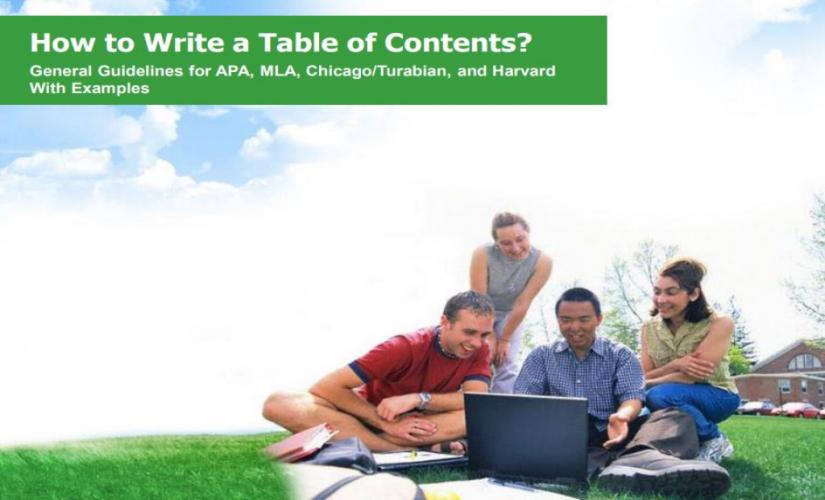
What Is a Table of Contents and Its Purpose
According to its definition, a table of contents (TOC) is a structured list that can be found at the beginning of books, reports, or other documents and provides key details on their chapters, sections, and major topics, along with their corresponding page numbers. The main purpose of writing a table of contents is to provide a clear and organized overview of a document’s text and help readers to understand its organization and flow of a material, making it easy to navigate (Heard, 2022). In this case, writers place their table of contents immediately after the title page and acknowledgments but before the main body of an entire work. Moreover, in lengthy or complex compositions, such as essays, research papers, theses, or dissertations, scholars often need to reference only specific information without reading them (Lewis et al., 2021). To achieve this purpose, they review a TOC page of a particular work under analysis and efficiently access the parts they need. Overall, a well-designed table of contents significantly improves the reader’s experience by providing a valid roadmap to a particular document’s text (Stadtlander, 2022). Besides, a dissertation table of contents should include all major sections, such as the introduction, literature review, methodology, results, discussion, conclusion, references, and appendices, along with their respective subsections and corresponding page numbers. In turn, here is an example template for writing a dissertation table of contents:
Difference Between a Table of Contents and an Outline
In essence, a TOC is a description of first-level headings (topics) and second-level headings (subtopics) within the paper’s body. For a longer document, writers may also include third-level titles to make the text good to read. To create a table of contents in Word, writers use the “References” tab to select “Table of Contents” and choose a style, ensuring that their document’s headings are formatted with the appropriate heading styles. Ideally, the length of papers determines the depth that authors go into detailing their writing in TOCs. For example, popular table of contents designs include hierarchical lists with indented subsections, dot leaders connecting titles to page numbers, and clear, consistent formatting with bold or italicized headings to distinguish different levels (Fitzpatrick, 2021). Basically, this feature means that shorter texts may not require third-level headings. In contrast, an essay outline is a summary of the paper’s main ideas with a hierarchical or logical structuring of the text. Unlike a TOC that only lists headings and subheadings, outlines capture these headings and then describe a written composition briefly under each one. As such, an outline provides a more in-depth summary of essay papers compared to a TOC.
| Criteria | Rule |
|---|---|
| Font and Style | Use a readable font (e.g., Times New Roman, Arial, Calibri) and a consistent font size (12-point). Use bold or italics sparingly for section titles. |
| Alignment and Indentation | Left-align main headings. Indent subsections to reflect hierarchy (e.g., 0.5 inches for each level). |
| Spacing | Single or 1.5 line spacing within entries. Double space between major sections. |
| Capitalization | Use title case (capitalize major words) for section titles. Ensure consistent capitalization style. |
| Page Numbers | Align page numbers to the right margin. Use dot leaders to connect section titles to page numbers. |
| Headings and Subheadings | Distinguish different levels of headings (e.g., main headings in bold, subheadings in regular font). Use numbering for chapters and sections (e.g., 1. Introduction, 1.1 Background). |
| Consistency | Apply formatting rules consistently throughout an entire TOC. Ensure formatting matches the rest of the document. |
| Lists of Figures and Tables | Follow same formatting rules as a main TOC. Place these lists immediately after a TOC page. |
| Margins | Use standard document margins (e.g., 1-inch margins on all sides). Ensure it fits within margins without overcrowding. |
| Templates and Styles | Use predefined styles or templates to ensure consistency. Adjust styles as necessary for specific requirements. |
- Easing a Document Navigation: Allows readers to quickly locate specific sections or chapters without having to search through an entire work.
- Providing an Overview: Offers a clear and structured outline of a paper’s text, helping readers understand the scope and organization at first glance.
- Improving Readability: Breaks down a written document into manageable sections, helping readers to follow and comprehend its content.
- Promoting Easy Reference: Enables readers to reference specific parts of a document easily, which is particularly useful for lengthy works, like dissertations, reports, or manuals.
- Making a Professional Presentation: Adds a level of professionalism and polish to a completed work, demonstrating attention to detail and careful organization.
- Aiding in Document Structuring: Helps writers to organize their thoughts and structure their papers logically, ensuring a coherent flow of information.
- Saving Time: Saves readers time by providing direct access to the sections they are interested in, improving overall efficiency.
- Supporting Academic and Technical Standards: Meets the requirements of academic and technical writing standards, which often mandate a TOC for comprehensive documents.
- Facilitating Review and Editing: Assists reviewers and editors in navigating a completed paper quickly, making the review and editing process more efficient.
- Enhancing Accessibility: Makes an entire document more accessible to a wider audience, including those who may need to find information quickly for research or reference purposes.
General Format
| Section | Description |
|---|---|
| Title Page | The title of an entire document with an author, institution, and date. |
| Abstract | A brief summary of a document’s content. |
| Acknowledgments | Section to thank those who helped in the creation of this document. |
| Table of Contents | A list including all sections and subsections with page numbers. |
| List of Figures or Illustrations | A list covering all figures in this document with page numbers. |
| List of Tables | A list presenting all tables in this document with page numbers. |
| List of Abbreviations | Definitions of abbreviations used in this document. |
| List of Symbols | Descriptions of symbols used in this document. |
| Chapters and Sections | The paper’s main content organized as chapters and sections. |
| Introduction | Overview, research problem, objectives, and significance. |
| Literature Review | Summary of existing research related to a study topic. |
| Methodology | Methods used for research, including data collection and analysis. |
| Results | Presentation and analysis of research findings. |
| Discussion | Interpretation of results, implications, and comparison with existing literature. |
| Conclusion and Recommendations | Summary of findings, conclusions drawn, and suggestions for future research. |
| Reference List | A list acknowledging all sources cited in a finished document and according to APA, MLA, Chicago/Turabian, Harvard, or other referencing formats. |
| Appendices | Additional materials, such as surveys, detailed data, and supplementary information. |
How to Write a Table of Contents in APA
When writing a TOC in the APA format, writers should capture all the headings in the paper – first-level, second-level, and even third-level. Besides this information, they should also include an abstract, references, and appendices. The correct way to format a table of contents is to list all main sections and subsections in a logical order, use clear and consistent headings, indent subsections, align page numbers to the right with dot leaders connecting the titles to them, and ensure it matches the overall document style and layout (Lang, 2017). Notably, while a TOC in the APA style has an abstract, this section is not necessary for the other formats, like MLA, Chicago/Turabian, and Harvard. Hence, an example of a TOC written in APA format is indicated below:
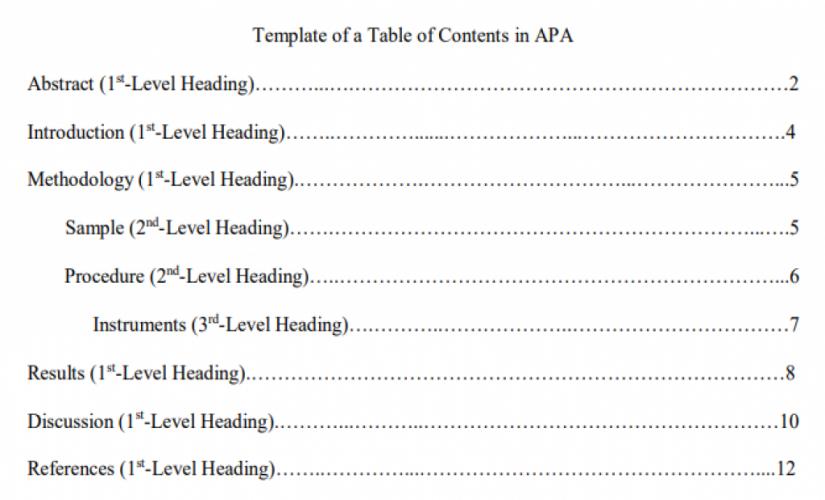
How to Write a Table of Contents in MLA
Unlike papers written in the APA style, MLA papers do not require a table of contents unless they are long enough. In this case, documents, like theses, dissertations, and books organized in the MLA format should have a TOC. For example, a table of contents in a book is a list of the chapters and major sections, along with their corresponding page numbers, providing an organized overview of its structure and text (Silvia, 2015). Even where a TOC is necessary, there is no specific method that a writer should use when writing it, and its structure is left to the writer’s discretion. To write a table of contents, writers list the main sections and subsections of their documents in the order they appear, using consistent formatting and including corresponding page numbers for each entry. However, when they have to include a TOC in their compositions, the information they capture should be much more than what would appear in the APA paper. Hence, an example of writing a TOC in MLA format is:
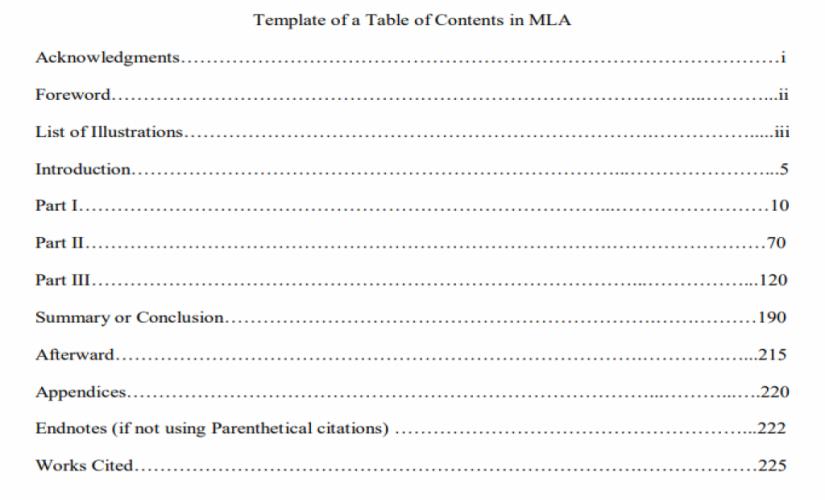
To create a good table of contents, writers ensure it is well-organized, accurately lists all sections and subsections with corresponding page numbers, and is formatted consistently for clarity and ease of navigation. In the case of writing a research paper, an example of an MLA TOC should be:
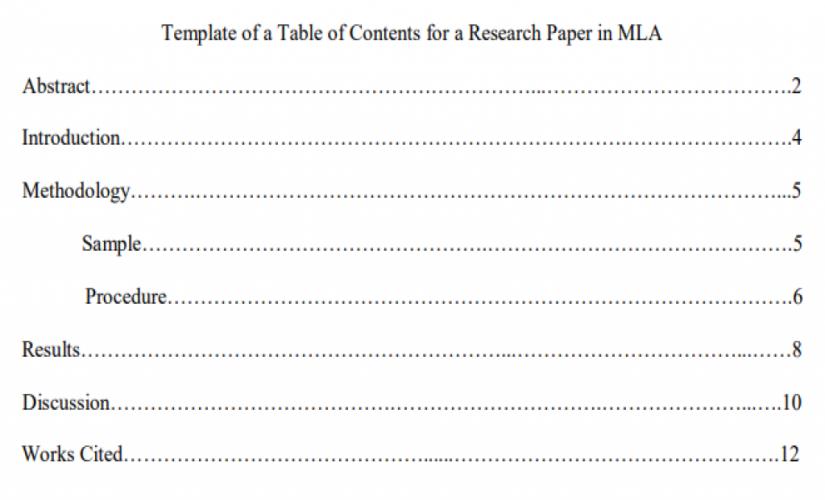
How to Write a Table of Contents in Chicago/Turabian
Like the MLA style, a Chicago/Turabian paper does not require writing a table of contents unless it is long enough. When a TOC is necessary, writers should capitalize on major headings. In this case, authors do not need to add a row of periods (. . . . . . . .) between the heading entry and the page number. Writers should use a table of contents format that lists all main sections and subsections in proper order, with clear headings, correct indentation for hierarchy, dot leaders connecting titles to right-aligned page numbers, and consistent formatting throughout (Stadtlander, 2022). Then, the arrangement of the text should start with the first-level heading, then the second-level heading, and, finally, the third-level title, just like in the APA paper. In turn, all the information that precedes the introduction part should have lowercase Roman numerals. Besides, the row of periods is only used for major headings. Therefore, an example of writing a TOC in Chicago/Turabian format is:
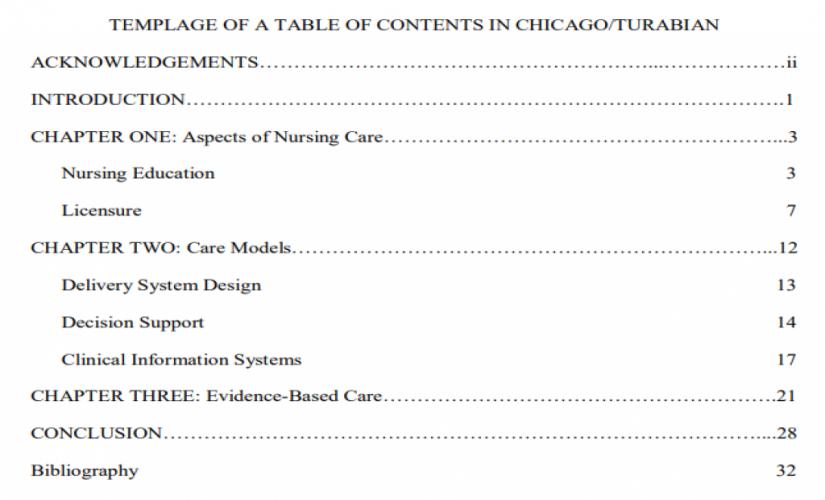
How to Write a Table of Contents in Harvard
Like in the other formats, writing a table of contents in the Harvard style is captured by having the title “Table of Contents” at the center of the page, in the first line. Basically, it comes after the title page and captures all the sections and subsections of Harvard papers. In other words, writers must indicate first-level headings in a numbered list. For example, to create a good table of contents, writers list the document’s main sections and subsections in the order they appear, apply consistent formatting, and include corresponding page numbers for each heading (Heard, 2022). Further on, scholars should align titles to the left side and capitalize them. In turn, if there is a need to show second-level headings, authors should list them under corresponding first-level headings by using bullet points. However, it is essential for students not to disrupt the numbering of first-level headings. Besides, writers should align second-level headings to the left side and indent them by half an inch and capitalize on a choosen piece. As a result, an example of writing a TOC in Harvard format should appear as below:
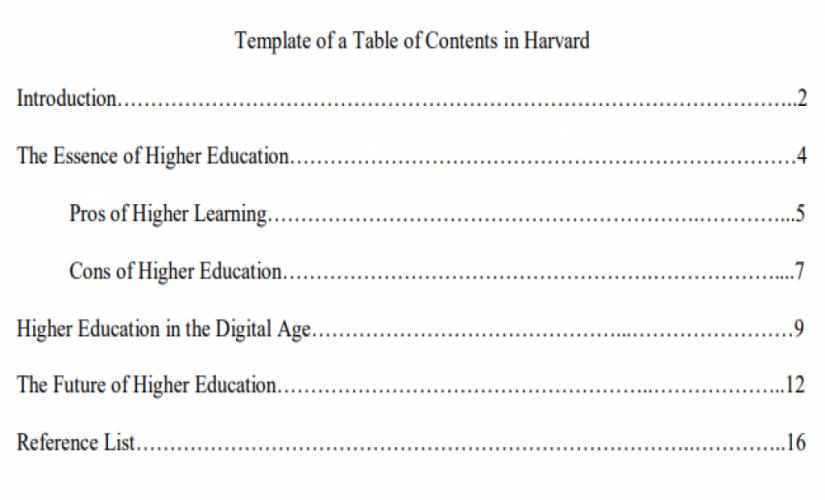
Common Mistakes
- Inconsistent Formatting: Using different fonts, sizes, or styles within a single TOC.
- Incorrect Page Numbers: Page numbers in a TOC do not match actual text pages.
- Missing Sections: Omitting important sections or subsections from a TOC.
- Overly Detailed Entries: Including too much detail makes a particular TOC hard to read.
- Lack of Subheadings: Not breaking down major sections into subheadings for clarity.
- Unclear Section Titles: Using vague or unclear titles does not reflect a completed text accurately.
- Improper Indentation: Incorrectly indenting headings and subheadings makes their hierarchy unclear.
- Inconsistent Capitalization: Using different capitalization styles for headings and subheadings.
- Failure to Update: Not updating a completed TOC after making changes to some sections of a final work.
- Missing List of Figures/Tables: Not including lists for figures and tables if they are present in a research paper.
- Ignoring Styles/Templates: Not using document styles or templates for doing a good TOC leads to inconsistency.
- Overly Long Titles: Including overly long section titles makes an entire TOC difficult to read.
Any TOC is an essential component of any academic paper, particularly for long documents, like theses, dissertations, and research papers. When students are writing a TOC, they should be careful to follow the applicable format’s rules and standards. Regardless of the format, writers should master the following tips when doing a TOC page:
- Write a TOC on a new page after the title page.
- Indicate first-level headings of the document in a numbered list.
- Indicate second-level headings under the corresponding first-level heading.
- If applicable, indicate third-level headings under the corresponding second-level heading.
- Write a specific page number for each heading.
- Put the provided content in a two-column table.
- Title the page with “Table of Contents.”
Fitzpatrick, R. (2021). Write useful books: A modern approach to designing and refining recommendable nonfiction . Useful Books Ltd.
Heard, S. B. (2022). The scientist’s guide to writing: How to write more easily and effectively throughout your scientific career . Princeton University Press.
Lang, T. A. (2017). Writing a better research article. Journal of Public Health and Emergency , 1 , 1–13. https://doi.org/10.21037/jphe.2017.11.06
Lewis, K. B., Graham, I. D., Boland, L., & Stacey, D. (2021). Writing a compelling integrated discussion: A guide for integrated discussions in article-based theses and dissertations. International Journal of Nursing Education Scholarship , 18 (1), 1–9. https://doi.org/10.1515/ijnes-2020-0057
Silvia, P. J. (2015). Write it up: Practical strategies for writing and publishing journal articles . American Psychological Association.
Stadtlander, L. (2022). Editorial: Rewriting a social science dissertation into a journal article and getting it published. Journal of Social, Behavioral, and Health Sciences , 16 (1), 94–102. https://doi.org/10.5590/jsbhs.2022.16.1.07
To Learn More, Read Relevant Articles
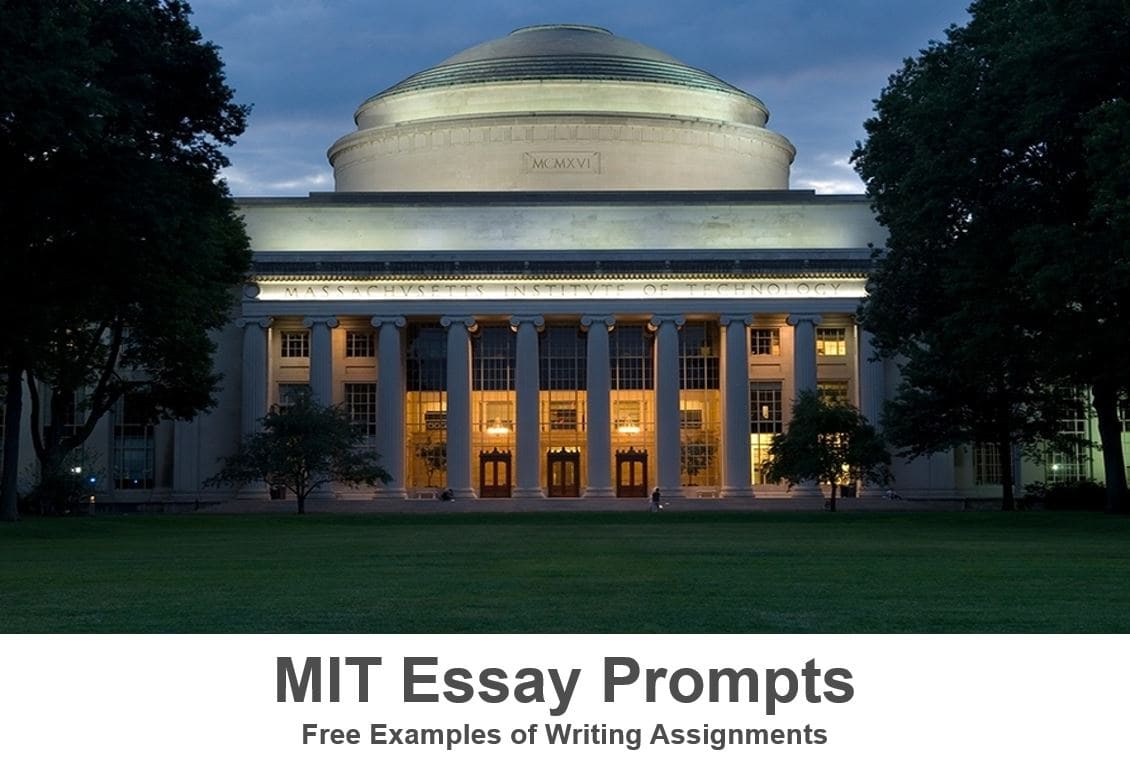
MIT Essay Prompts: Free Examples of Writing Assignments in 2024
- Icon Calendar 26 August 2020
- Icon Page 2576 words
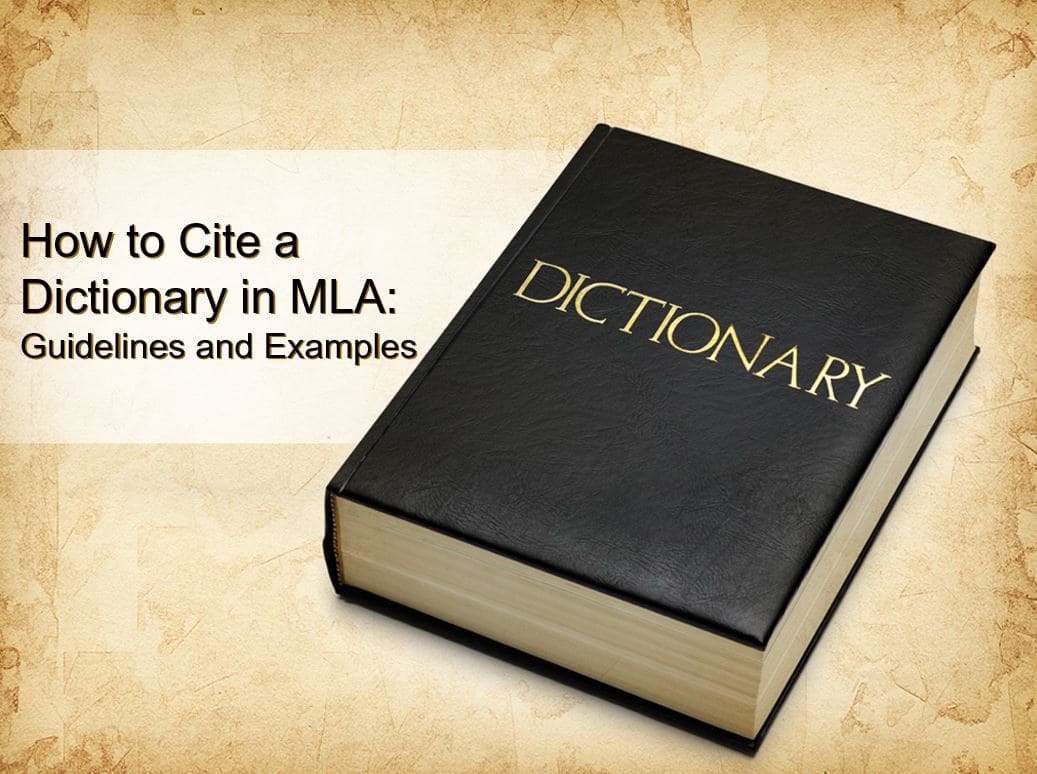
How to Cite a Dictionary in MLA 9: Guidelines and Examples
- Icon Calendar 24 August 2020
- Icon Page 1342 words
- Bipolar Disorder
- Therapy Center
- When To See a Therapist
- Types of Therapy
- Best Online Therapy
- Best Couples Therapy
- Managing Stress
- Sleep and Dreaming
- Understanding Emotions
- Self-Improvement
- Healthy Relationships
- Student Resources
- Personality Types
- Sweepstakes
- Guided Meditations
- Verywell Mind Insights
- 2024 Verywell Mind 25
- Mental Health in the Classroom
- Editorial Process
- Meet Our Review Board
- Crisis Support
A Table of Contents in APA Format
General guidelines.
- Table of Contents
APA style does not require a table of contents, but there are cases where you may need to include one. For example, your instructor may specify that your paper must be submitted with a table of contents. A table of contents can be particularly helpful in cases where your paper is lengthy or covers a lot of material, such as a thesis paper or dissertation. Research papers, in particular, may benefit from the addition of a table of contents.
APA style is the official publication style of the American Psychological Association. APA style is used in psychology courses as well as other social science classes including those in social science, behavioral sciences, and education.
The table of contents serves as a basic roadmap of your paper. It should list all of the major headings and subheadings within the body of your paper. For a standard psychology paper, it might include listings for the introduction, method, results, and discussion sections of your paper.
While the APA may not specify guidelines for a table of contents, you should use the basic APA format for formatting your table of contents:
- Use one-inch margins on all sides
- Use 12-point Times New Roman font
- Double-space
Since APA does not require a table of contents, you should always refer to your instructor’s guidelines when deciding whether or not to include one.
It is also important to note that the 7th edition of the Publication Manual of the American Psychological Association was published in 2020, and included updated guidelines on many topics.
For example, while the previous edition of the style manual required a running head on each page of a paper, the 7th edition has eliminated that requirement on student papers unless your instructor specifies to include it. Always ask first.
If you are using a standard APA paper format, your table of contents should include the following sections:
- Introduction
The above format may work well for a standard lab report or research paper. However, your table of contents will look much different if you are writing something such as a critique, essay, or case study.
Notice, that the table of contents does not include the abstract or acknowledgments pages. When applicable, it should list the appendices and the lists of tables and figures.
The exact order of your paper depends largely on the type of paper you are writing. In general, your paper should be presented in the following order:
- Main Body of Paper
Table of Contents Format
Because there is no standard format for a table of contents in APA style, you should always defer to the provided guidelines for your assignment.
If your instructor does not have a preferred format, consider using the following:
- Title the page “Table of Contents” and center the title at the top of the page.
- Most papers should include at least two levels of headings, up to five levels.
- Level one headings will be for main topics, such as chapter titles like "Chapter One; Name of Chapter," or research sections like "Method," "Results," and "Discussion."
- All level-one headings should be flush-left and sub-headings should be indented five spaces deeper than the last.
- All heading levels should be in title case, capitalizing the first letter of each word. The font type, style, and size stay the same for each level.
- The page number for each heading is formatted flush-right. Include dot leaders between the headings and the page number to improve readability.
While you might not think that following APA format is important, it is one of those areas where students can lose points for making small errors. It pays to spend a little extra time and attention making sure that your paper is formatted in proper APA style.
- If you need help, you can get assistance from your school's writing lab.
- Getting your own copy of the latest edition of the APA publication manual can be very helpful.
- Always refer to any instructions or guidelines that were provided by your course instructor.
- There is a helpful feature in most word processors that you can use to pre-format your paper in APA style. It takes a little effort to set it up, but well worth it in the end, especially for longer documents. You can save the style to apply to your future papers saving you the effort next time.
For those writing a paper to submit for publication, check with the publisher for any specific formatting requirements that they may have.
American Psychological Association. Publication Manual of the American Psychological Association (7th ed.) ; 2020.
By Kendra Cherry, MSEd Kendra Cherry, MS, is a psychosocial rehabilitation specialist, psychology educator, and author of the "Everything Psychology Book."

- Langson Library
- Science Library
- Grunigen Medical Library
- Law Library
- Connect From Off-Campus
- Accessibility
- Gateway Study Center

Email this link
Thesis / dissertation formatting manual (2024).
- Filing Fees and Student Status
- Submission Process Overview
- Electronic Thesis Submission
- Paper Thesis Submission
- Formatting Overview
- Fonts/Typeface
- Pagination, Margins, Spacing
- Paper Thesis Formatting
- Preliminary Pages Overview
- Copyright Page
- Dedication Page
- Table of Contents
- List of Figures (etc.)
- Acknowledgments
- Text and References Overview
- Figures and Illustrations
- Using Your Own Previously Published Materials
- Using Copyrighted Materials by Another Author
- Open Access and Embargoes
- Copyright and Creative Commons
- Ordering Print (Bound) Copies
- Tutorials and Assistance
- FAQ This link opens in a new window
Table of contents
The Table of Contents should follow these guidelines:
- All sections of the manuscript are listed in the Table of Contents except the Title Page, the Copyright Page, the Dedication Page, and the Table of Contents.
- You may list subsections within chapters
- Creative works are not exempt from the requirement to include a Table of Contents
Table of contents example
Here is an example of a Table of Contents page from the Template. Please note that your table of contents may be longer than one page.

- << Previous: Dedication Page
- Next: List of Figures (etc.) >>
- Last Updated: Jul 18, 2024 9:46 AM
- URL: https://guides.lib.uci.edu/gradmanual
Off-campus? Please use the Software VPN and choose the group UCIFull to access licensed content. For more information, please Click here
Software VPN is not available for guests, so they may not have access to some content when connecting from off-campus.
Home » Blog » Table of Contents - Definition, Types, Formats & Examples
Table of Contents – Definition, Types, Formats & Examples
Table of contents.
The Table of Contents (TOC) is very important in the academic world, especially for research projects and final year dissertations. The Table of Contents can be considered the map of your research paper, a tool that helps readers find their way through your ideas.
Readers, from peers and professors to experts in your field, can find specific areas of your study without having to look through the whole document. This makes the structure of your work easier to navigate and understand. This can help them understand your work better and help them understand it better overall.
Table of Contents in a Research Paper
While the student is writing their final year project, the Table of Content helps them keep track of everything. With the Table of Content, students can create a structured framework, or skeleton, for their work. This helps them stay focused on their research’s main goals and sub-questions. This methodical order also forces them to put their ideas in a way that makes sense so that their arguments make sense from one section to the next.
Table of Contents Definition
The Table of Contents is an important part of any extensive written book, research paper, report, or dissertation . The Table of Content gives a detailed list of a document’s sections and important subsections. This list is usually set up in a hierarchy.
Each entry in the TOCs refers to a different part of the work and gives the page numbers where readers can find it. Usually, the Table of Contents is at the beginning of the document. It acts as a navigational guide and gives a quick overview of the structure and layout of the paper.
The Table of Contents is carefully structured with different levels of headings and subheadings that match how the main body of the work is organized. These levels show how the content is organized, with the main headings representing broad categories and the subheadings representing more specific details within these categories.
Some TOCs also has a list of figures, tables, and appendices, which makes it easier for readers to find these parts. So, the TOC acts as a map, giving readers a quick idea of how the document is put together and helping them move quickly through the work.
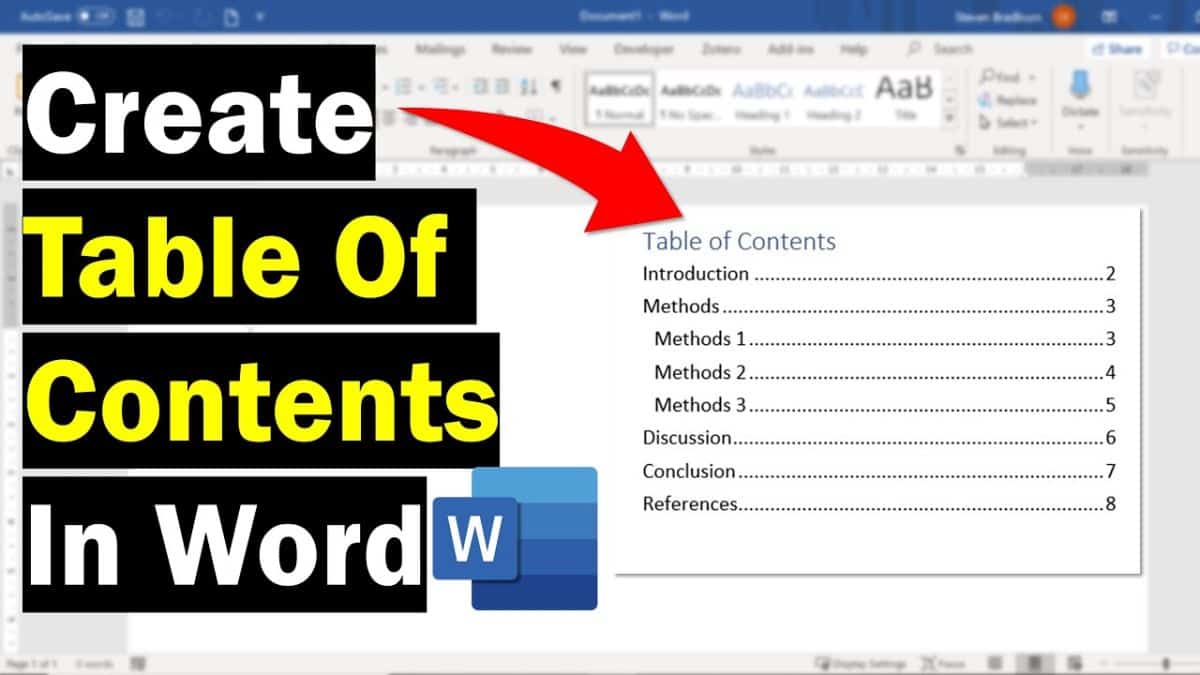
The Importance of Table of Contents
Easy navigation for readers.
The Table of Contents is an important tool that helps readers find their way around. Whether it’s a novel, a research paper , or a business report, the reader may want to go straight to a specific part of the text without reading the whole document. This is made easy by the Table of Contents, which has a detailed list of sections, subsections, and the page numbers that go with them.
With a TOCs, Readers can quickly find the content they want, which saves them time and makes reading more enjoyable and effective. This feature of the TOC can’t be overstated, especially when it comes to academic research or business documentation, where readers often need to refer back to the same sections.
Provides an Overview of the Content
The Table of Contents is also very important because it gives an overview of the content. Before getting into the details of a document, a reader might want to get a sense of its scope and depth. As a small version of the whole document, the TOCs gives the reader just that. It tells what the document is about, the main points, and how the whole paper is put together. The reader can understand how the information flows, guess what will come next, and see how the different parts fit together. By giving this overview, the TOC makes reading a more interesting and informative experience.
Content Organization
The Table of Contents is important in putting the work together and showing where to go next. Creating a TOC can help the author plan and organize their thoughts and ideas in a way that makes sense. This order becomes the document’s backbone. It guides the writing process and ensures the work stays on track and makes sense. Also, the clear divisions between sections and subsections in the TOC help readers follow the author’s train of thought. They can easily find where they are in the document and see how each part fits into the whole. So, the TOC is important for making a structured, well-organized document and making it easier for the reader to understand and remember the content.
Types of Table of Contents
Short-form vs. long-form table of contents.
There are different kinds of Tables of Contents in the documentation and content creation. Each is made for a different kind of document and a different set of needs. Most of the time, people use short-form and long-form TOCs. As its name suggests, the short-form Table of Contents gives a quick document overview.
It mostly lists the main sections and main subheadings, which makes it perfect for short documents or ones where a general overview is enough. On the other hand, the long-form TOC goes into much more detail, listing not only the main headings but also all the different subheadings and sub-subheadings. This type of Table of Contents is best for long, complicated documents where each piece of content adds something different to the story.
Descriptive Table of Contents
The descriptive Table of Contents is another interesting type. In contrast to the short and long-form Table of Contents, which are mostly just lists of headings, the descriptive TOCs also includes a short summary or synopsis of each section. This method gives the reader a better idea of what each section is about and helps them understand the structure and content of the document better. A descriptive Table of Contents is very helpful when each chapter or section can stand independently, like in anthologies, edited books, or collections of essays.
Hierarchical Table of Contents
A hierarchical Table of Contents shows the structure of the document. It shows the order of sections, sub-sections, and lower-level headings with indentation, typography, and sometimes even pictures. This kind of TOCs is useful for complicated documents because it lets the reader see how the content is organized and how the different parts relate.
The Figure-centric and Table-centric Table of Contents
The figure-centric and table-centric Table of Contents is made for documents like scientific research papers or technical manuals with many figures or tables. A table-centric TOCs does the same thing for tables as a figure-centric TOCs does for figures.
These specialized Table of Contents make it easy for readers to find and refer to the visual or tabular information that may be important for them to understand the text. So, the type of TOCs chosen will depend on what the document is about and what the reader needs.
Table of Contents Formats: The Classic Method
Traditional book format.
A traditional book format, Table of Contents, is usually a detailed and hierarchical list of chapters or sections at the beginning of a book. It lists the title of each chapter or section and the page number where it begins. When a book has more than one part or volume, the TOCs often lists the titles of these larger sections.
Traditional Book Format Table of Contents Example
A fiction book table of contents:.
Acknowledgments…………………………………..iii Introduction………………………………………..v
PART ONE: THE BEGINNING
Chapter 1: The Mysterious Stranger……………………1 Chapter 2: An Unexpected Journey…………………..15 Chapter 3: Friends and Foes……………………………32
PART TWO: THE MIDDLE
Chapter 4: The Hidden World…………………………51 Chapter 5: Secrets Revealed………………………….68 Chapter 6: Battles and Betrayals…………………….84
PART THREE: THE END
Chapter 7: The Final Stand…………………………..100 Chapter 8: Homecoming……………………………..118 Epilogue…………………………………………..131
A Non-Fiction Book Table of Contents:
TABLE OF CONTENTS
Preface…………………………………………..vii Introduction…………………………………….xiii
PART I: FOUNDATIONS
Chapter 1: Introduction to The Topic………………..1 Chapter 2: Historical Overview……………………..20 Chapter 3: Key Concepts……………………………36
PART II: CASE STUDIES
Chapter 4: Case Study One………………………….55 Chapter 5: Case Study Two………………………….72 Chapter 6: Case Study Three………………………..90
PART III: CONCLUSIONS
Chapter 7: Analysis and Interpretations……………110 Chapter 8: Future Directions………………………128 Bibliography…………………………………….140 Index…………………………………………..150
Digital Formats
In digital formats like e-books, websites, and digital reports, the main purpose of the Table of Contents is to help you find your way around. But it usually comes with extra features that use the benefits of digital technology.
The Table of Contents in a digital report or a PDF document often works the same way, with links to the relevant sections. Some PDF viewers even have a navigation pane where the TOCs stays visible and accessible as you read the document. This feature makes it easy to move around, especially in long and complex documents.
Digital Formats Example
Introduction…………………………………Link to Section Chapter 1: Basics of Digital Marketing………….Link to Section 1.1 Definition and Scope………………….Link to Section 1.2 Types of Digital Marketing…………….Link to Section Chapter 2: Social Media Marketing………………Link to Section 2.1 Platforms…………………………..Link to Section 2.2 Strategy and Planning…………………Link to Section Chapter 3: Search Engine Optimization (SEO)……..Link to Section 3.1 Basics of SEO……………………….Link to Section 3.2 Keyword Research…………………….Link to Section Chapter 4: Email Marketing…………………….Link to Section 4.1 Building an Email List……………….Link to Section 4.2 Crafting Effective Emails…………….Link to Section Conclusion………………………………….Link to Section References………………………………….Link to Section
Table of Contents Format for Academic Research Papers
The academic format of a Table of Contents serves as a road map for research papers, dissertations, theses, or any other scholarly documents, giving a detailed hierarchical structure of the content. Like other TOCs, an academic Table of Contents lists the document’s main sections and the page numbers where they begin. But academic TOCs often goes into more detail, showing not only the main chapters but also different levels of subheadings. This ensures that a scholarly work’s complex structure is shown accurately. This is especially important for long research projects involving complex arguments and looking into many different topics.
In this academic format, Table of Contents, each entry has a page number, and main sections and subsections are separated by indentation. Remember that the TOC’s structure can change depending on your institution’s rules or the academic style you’re using (like APA, MLA, or Chicago Style).
Academic Format Example
Abstract…………………………………………. ii Acknowledgments………………………………. iii List of Tables…………………………………… iv List of Figures………………………………….. v
CHAPTER 1: INTRODUCTION………………………. 1 Problem Statement………………………….. 2 Research Questions………………………….. 3 Significance of the Study……………………. 4
CHAPTER 2: LITERATURE REVIEW………………… 8 Theoretical Framework………………………. 9 Review of Related Literature………………… 11
CHAPTER 3: METHODOLOGY……………………… 20 Research Design……………………………. 21 Participants……………………………….. 24 Data Collection……………………………. 25 Data Analysis……………………………… 27
CHAPTER 4: RESULTS……………………………. 30
CHAPTER 5: DISCUSSION……………………….. 40 Implications……………………………….. 41 Recommendations for Future Research………… 43
References……………………………………… 50 Appendices……………………………………… 54
How to Create Table of Contents: A Step-by-Step Guide
Creating table of contents manually.
A Table of Contents (TOC) can be created in different ways, such as manually or by using a software such as Microsoft Word or Google Docs that creates TOCs automatically.
If you are working with a small document and want full control over the details of your Table of Contents, making one manually might be the best option. With this method, you just type out the title of each section and the page number that goes with it in your document. Make sure that your formatting and indentation are consistent so that your sections and subsections show the correct order.
Remember that creating a TOCs manually can take a long time for long documents, and you’ll have to update it manually if you add, remove, or change the order of sections.
Creating Table of Contents in Microsoft Word
Microsoft Word has a great tool for automatically making a Table of Contents, which can save you a lot of time and work, especially for longer documents.
To make a Table of Contents in Word, you must first give the text you want to include in the Table of Contents heading styles (Heading 1, Heading 2, etc.). Word’s “Home” tab is where you’ll find these heading styles. Once you’ve added these styles, you can add a Table of Contents by going to the “References” tab and clicking “Table of Contents.” Based on the heading styles you used and the page numbers, MS Word will automatically make a TOCs. When you make changes to your document, you can update the Table of Contents by right-clicking on it and choosing “Update Field.”

Creating Table of Contents in Google Docs
Google Docs also lets you make an automatic Table of Contents in a similar way. To do this, use the toolbar at the top to add heading styles to your text. Once you’ve done this, click where you want your Table of Contents to be, then go to “Insert,” choose “Table of Contents,” and you’ll see two options: one with links and one with page numbers. If your document is meant to be used online, links are the way to go. Choose page numbers if you want to print the document. If you make changes to your document, you can update the Table of Contents by clicking on it and then clicking the “Refresh” icon that appears.

Table of Contents Best Practices
No matter what method you use, the best thing you can do is make sure your Table of Content is clear, correct, and easy to navigate. It should give a quick summary of your document’s content and structure, making it easy for people to find the information they need. Check your Table of Content often to make sure it matches the content of your document, especially after making major changes.
The Bottom Line
In conclusion, the importance of a Table of Contents in any document – whether it’s a book, an academic paper, an eBook, or a report. It helps readers find their way around the document by giving them an organized overview of the content and showing them how the document is structured. A well-written TOCs tells readers right away what the document is about and how it is organized, making it easy for them to find specific sections.
If you like this article, see others like it:
Balancing Work and Life: Achieving Success in Nigeria’s Competitive Job Market
2024 complete nigeria current affairs pdf free download, 2024 nigeria current affairs quiz questions & answers, learn how to trade forex: a beginner’s guide, 5 corporate team building activities ideas for introverted employees, related topics, how to search for journals for a research project, a step-by-step guide to writing a comparative analysis, signs it’s time to re-evaluate your career goals, 5 common career change fears and what to do, how to plan an affordable vacation as a student.

Table of Contents APA
Ai generator.
Writing academic papers and essays in APA (American Psychological Association) format requires adherence to specific guidelines and formatting rules. Among these essential elements is the Table of Contents, which serves as a roadmap for readers, enabling them to navigate through the document efficiently. In this article, we will delve into the definition and purpose of a Table of Contents in APA format, provide a step-by-step guide on how to create one, address frequently asked questions, and explore the importance of this element in academic writing.
1. Apa Table Of Contents Template
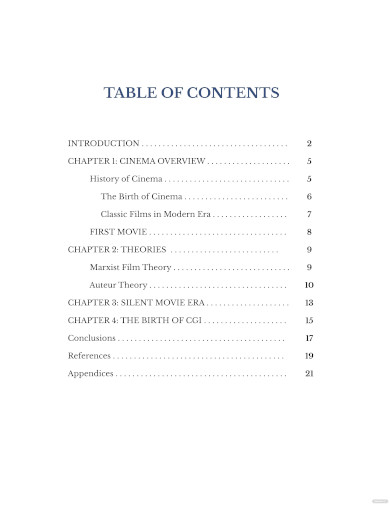
- Google Docs
- Apple Pages
2. Employee Handbook Table Of Contents Template
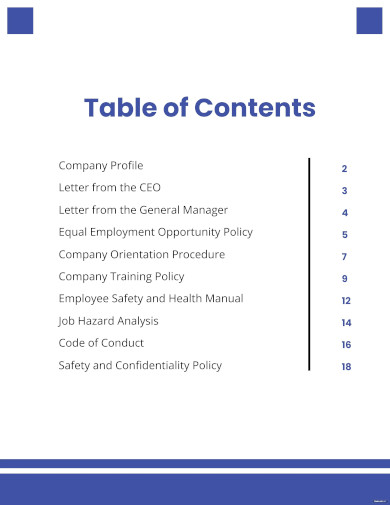
3. Research Paper Table of Contents Template
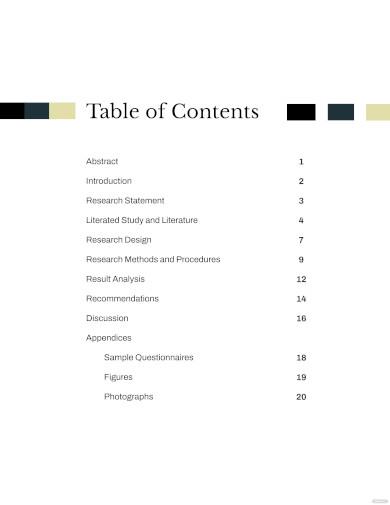
4. Business Plan Table of Contents Template
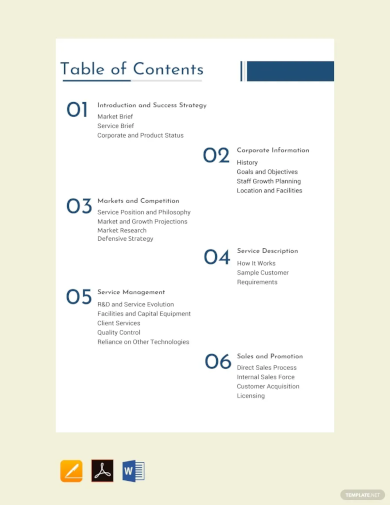
5. Research Proposal Table Of Contents Template
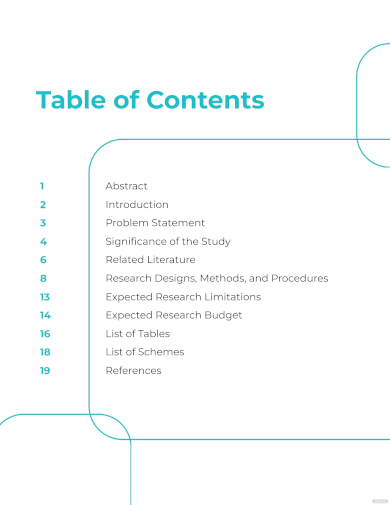
6. APA 6th Edition Table of Contents
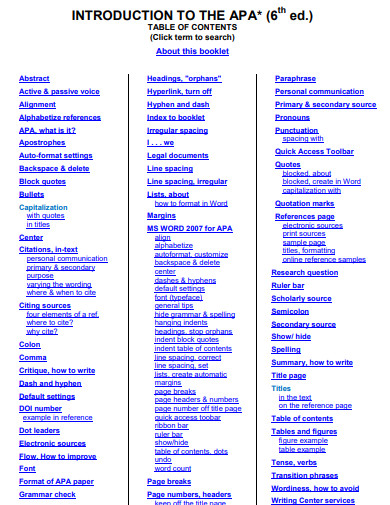
7. Table of Contents APA Format
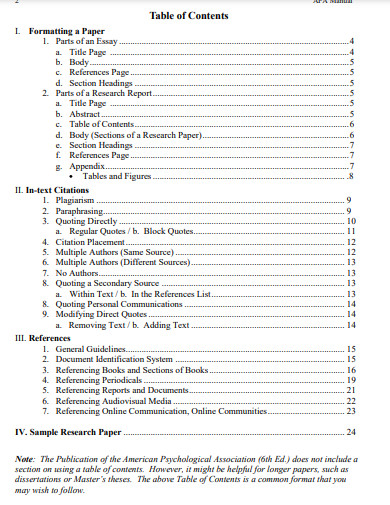
Size: 884 KB
8. Table of Contents APA Referencing Style
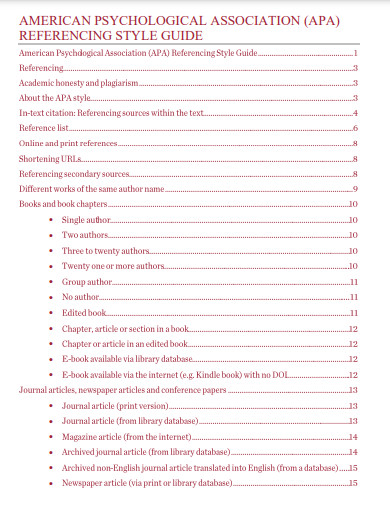

9. Table of Contents APA Example
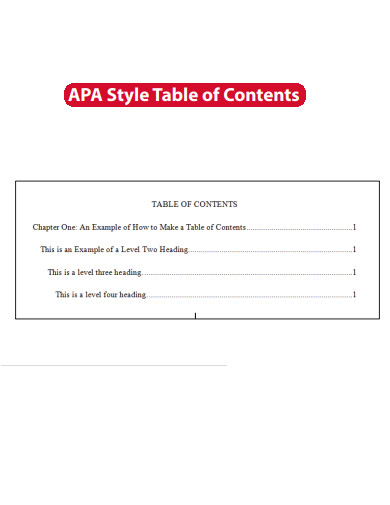
Size: 496 KB
10. Table of Contents APA Template

Size: 622 KB
11. Table of Contents APA 7th Edition

Size: 42 KB
12. Sample Table of Contents APA
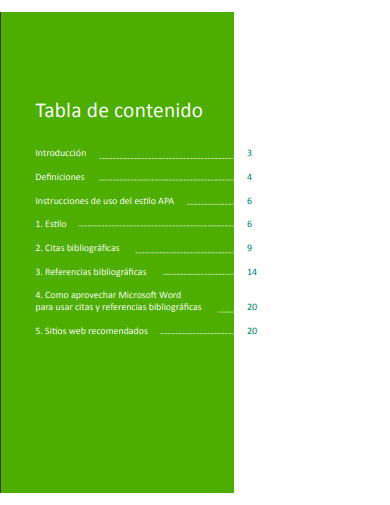
Size: 924 KB
13. Table of Contents APA Bibliography
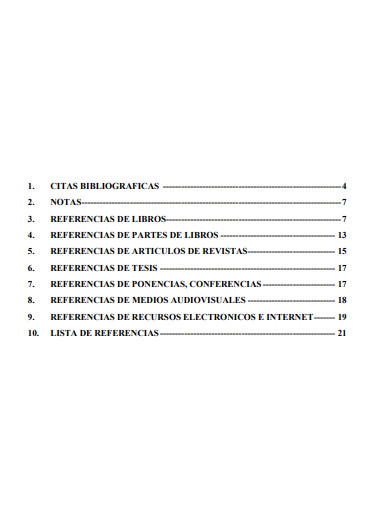
Size: 684 KB
14. Simple Table of Contents APA

Size: 975 KB
15. Table of Contents APA Guide
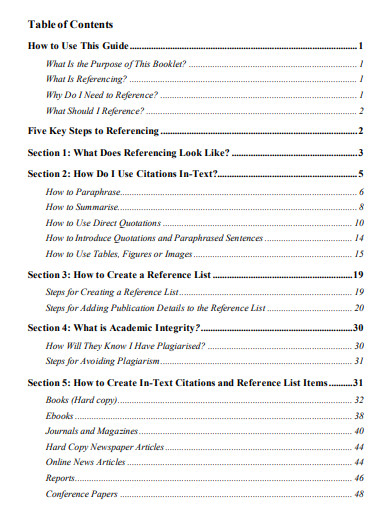
16. Table of Contents APA Edition

17. Table of Contents APA 6th Edition
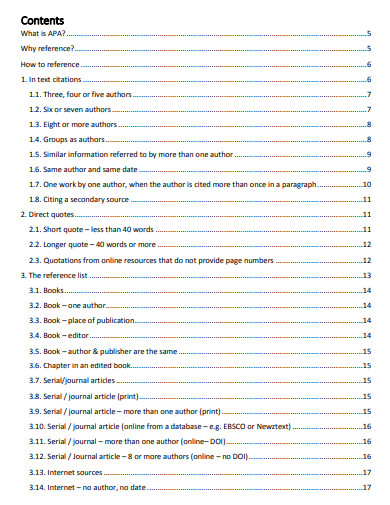
Size: 775 KB
18. Table of Contents APA Style
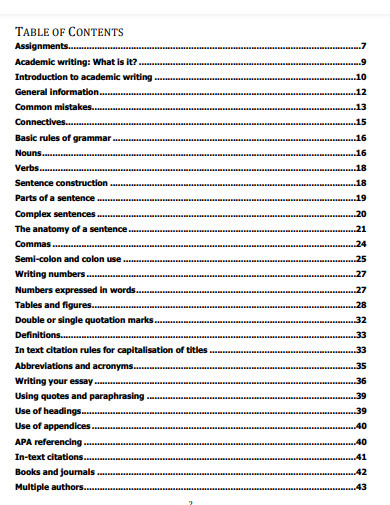
19. Table of Contents And Figures APA
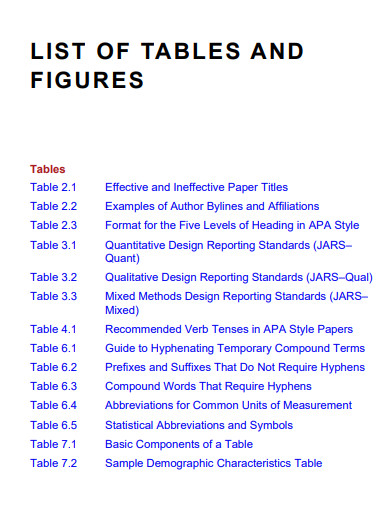
Size: 23 MB
20. Table of Contents Research Paper APA
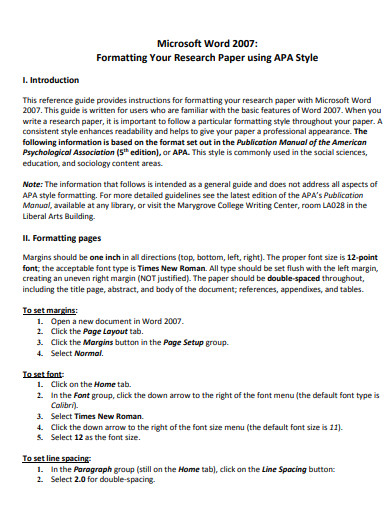
Size: 223 KB
21. Basic Table of Contents APA
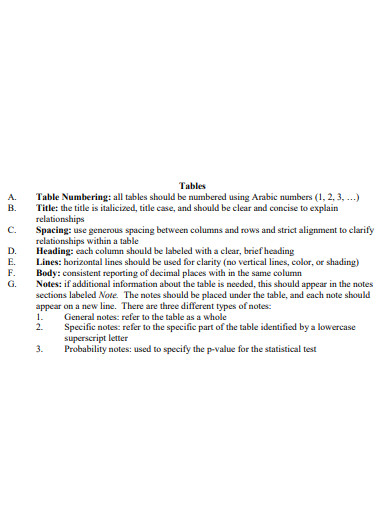
Size: 137 KB
22. Standard Table of Contents APA
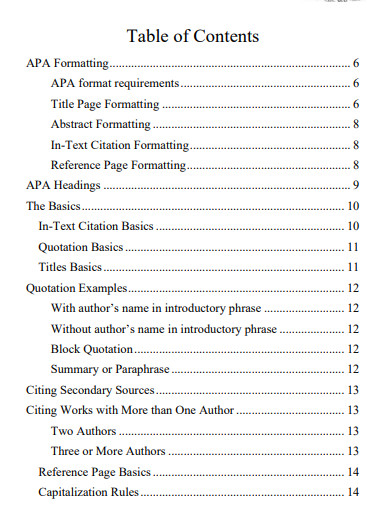
Size: 787 KB
What is A Table of Contents in APA format?
A Table of Contents in APA format is a structured list that appears at the beginning of a research paper, dissertation, or any other lengthy document, summarizing its contents and providing page references for each section. It allows readers to locate specific information quickly and facilitates efficient navigation throughout the document. The Table of Contents serves as a visual aid, providing an organized overview of the document’s structure, headings, and subheadings.
How to Write a Table of Contents in APA Format
Crafting a well-organized and reader-friendly Table of Contents is an essential aspect of writing academic papers in APA (American Psychological Association) format. This step-by-step guide will walk you through the process of creating a Table of Contents that adheres to APA guidelines. By following these simple instructions, you can ensure that your document is structured effectively, enabling readers to navigate your work with ease and locate the information they seek efficiently. Let’s dive into the details of this comprehensive guide on creating a Table of Contents in APA format.
Step 1: Prepare Your Document Structure
Before creating the Table of Contents, ensure that your document has a well-structured outline format . Begin by developing a clear introduction that provides an overview of your topic or research question. Follow this with the body of your paper, consisting of relevant sections and subsections that present your arguments or findings. Finally, conclude your paper with a thoughtful summary or conclusion paragraph.
Step 2: Insert Headings and Subheadings
Using appropriate headings and subheadings is crucial in APA format. Place your cursor at the beginning of each major section or subsection and apply the appropriate heading style. APA format utilizes specific heading levels, such as Level 1 for main sections and Level 2 for subsections, to maintain a consistent hierarchy and ensure clarity.
Step 3: Assign Page Numbers
Once your headings and subheadings are in place, assign page numbers to each section of your document. APA format typically requires page numbers to be positioned at the top right corner of each page. Ensure that your page numbering is continuous throughout the entire document, including the Table of Contents.
Step 4: Generate the Table of Contents
After completing the previous steps, it’s time to generate the Table of Contents. In most word processing software, this feature can be found under the “References” or “Layout” tab. Select the appropriate formatting options, such as including dot leaders between the heading titles and corresponding page numbers. Once generated, review the Table of Contents to ensure accuracy.
Why is the Table of Contents important?
The Table of Contents provides readers with a concise overview of the document’s structure, allowing them to navigate through the content efficiently. It saves time by providing quick access to specific sections, enabling readers to locate relevant information promptly.
Should the Table of Contents be on a separate page?
Yes, the Table of Contents should be placed on a separate page following the cover page and abstract (if applicable). This ensures that it is easily identifiable and distinguishes it from the main body of the document.
Can I change the formatting of the Table of Contents?
Yes, you can customize the formatting of the Table of Contents to some extent. However, it is essential to follow APA guidelines for font style, size, and spacing. Straying too far from the standard format may compromise the professionalism and consistency of your document.
In academic writing, the Table of Contents serves as a valuable navigational tool, guiding readers through the complex structure of a research paper or dissertation. By following the APA format guidelines and employing a clear and organized structure, you can create a comprehensive Table of Contents that enhances the understanding of your research paper’s structure, saving time and improving the overall readability of your work. So, the next time you embark on an academic writing journey, remember the significance of a well-crafted Table of Contents in APA format. By meticulously following the step-by-step guide provided in this article, you can confidently present your research, arguments, or findings while maintaining the professional standards expected in academic writing. So, check things you have to know about writing papers and essays here and make sure to incorporate a well-designed Table of Contents, as it is a vital component of any scholarly document. Happy writing!
Text prompt
- Instructive
- Professional
10 Examples of Public speaking
20 Examples of Gas lighting
- Dissertation & Thesis Guides
- Basics of Dissertation & Thesis Writing
- How to Create a Table of Contents for Dissertation, Thesis or Paper & Examples
- Speech Topics
- Basics of Essay Writing
- Essay Topics
- Other Essays
- Main Academic Essays
- Research Paper Topics
- Basics of Research Paper Writing
- Miscellaneous
- Chicago/ Turabian
- Data & Statistics
- Methodology
- Admission Writing Tips
- Admission Advice
- Other Guides
- Student Life
- Studying Tips
- Understanding Plagiarism
- Academic Writing Tips
- Essay Guides
- Research Paper Guides
- Formatting Guides
- Basics of Research Process
- Admission Guides
How to Create a Table of Contents for Dissertation, Thesis or Paper & Examples

Table of contents
Use our free Readability checker
A dissertation table of contents is a list of the chapters and sections included in a dissertation or thesis, along with their page numbers. It helps to navigate the document easily and locate specific information. Each chapter or section should be listed with its corresponding page number. The table of contents should be formatted according to the guidelines of the specific style guide being used, such as APA or MLA.
We would guess that students usually start working on the table of contents at the last minute. It is quite apparent and makes sense, as this is the list of chapters and sections with page locations. Do you think it's easy?
From our experience, it can be quite tricky to organize everything according to APA, Chicago, or any other academic writing style. In this blog, we will discuss how to write a table of contents for a research paper , thesis or dissertation in Microsoft Word. We will create it together to guide students through the process.
Also, here you will find examples of table of contents created by thesis writers at StudyCrumb . Let’s go!
What Is a Table of Contents: Definition
It is obvious that the table of contents (TOC) is an essential manuscript part you can’t skip. If you are dealing with a dissertation, thesis or research paper, you need to know how to build it in accordance with academic guidance. This is a detailed roadmap for your work and outlined structure you can follow for a research presentation.
In case you are working on an essay or report, you may not include the table of contents, as it is a short academic text. But for the research paper, thesis or dissertation, table of contents is essential and required. It is possible to say the same about any Master’s project. It should be located between the dissertation abstract and introduction chapter. In most cases, it is about 2-3 pages long.
Our expert dissertation writing service prepared a great template that can be used for your work. Make your research formatting easy with ready solutions!
Types of Table of Contents
How to choose which table of contents will fit your research paper, thesis, dissertation, or report best? Make a decision based on your work length. Some academic writing styles, such as APA paper format or MLA style , have specific formatting for this list.
However, we will outline the most commonly used typology:
- Single-level table of contents. At this type, we use only chapters. For instance, you will have an Introduction, Literature Review, methodology, and other chapters with page numbers. It can be used for shorter research work. For long writing forms like manuscripts, it can be too broad, and you will need to go into details.
- Subdivided table of contents. The most frequently used form to organize the contents table. It will include not only chapters but also sections — a level 2 subheading for each part. It will help to be more specific about what to expect in each part of your research work.
- Table of contents with multiple levels. This is a more divided structure, including subheadings with a level 3 for each section. Quite often, those subheadings can be rewritten or deleted during the last editing. It is essential to keep them in the right order.
Before you decide which type will work best for you, let us share with you some examples of each formatting style.
Example of Table of Contents With a Single Level
Introduction: The Misinformation Roots ………..…… 3 Literature Review .....................................….....………… 10 Research Methodology and Design ……................. 24 Results.............................................................................. 28 Discussion ....................................................................... 32
Sometimes, you will need to put an extra emphasis on subsections. Check this layout to see how your subheadings can be organized.
Example of Table of Contents Page with Subdivided Levels
Introduction: Information War ............……………….. 3 Background…………………………………….………..…… 4 Current State ……………………………………...…...…… 5 Defining Research Questions………………………. 9 Literature Review………………………...……………..……... 11 The Roots of Information Warfare ………....… 11 Information Wars …………………………….………..… 14 Cyber Wars Research ........................................ 17
If you are working on a lengthy, complex paper, this outline will suit your project most. It will help readers navigate through your document by breaking it down into smaller, more manageable sections.
Multi-Level Table of Contents Page Example
Introduction……………………………………………….......……….… 3 Emergence of Climate Change ………..……....….….. 3 Key Activist Groups in Climate Change .............. 5 Greenpeace International ………..…………......... 9 European Climate Foundation …….……………. 10 WWF ……………………………………….……….............. 11 Significant Movements ……………….………....……… 13 Literature Review ……………………………………......…………. 15
What Sections Should Be Included in a Table of Contents?
To start with, the scientific table of contents should include all chapters and its subheading. It is important to choose the formatting that will give your readers a full overview of your work from the very beginning. However, there are other chapters that you may miss constructing the 2-pager table. So, let's look at all you need to include:
- Dissertation introduction
- Literature review
- Research methodology
- Results section
- Dissertation discussion
- Conclusion of a thesis
- Reference list. Mention a number of a page where you start listing your sources.
- Appendices. For instance, if you have a data set, table or figure, include it in your research appendix .
This is how the ideal structured dissertation or research paper table of contents will look like. Remember that it still should take 2 pages. You need to choose the best formatting style to manage its length.
Tables, Figures, and Appendices in TOC
While creating a table of contents in a research paper, thesis or dissertation, you will need to include appendices in each case you have them. However, the formatting and adding tables and figures can vary based on the number and citation style. If you have more than 3 tables or figures, you may decide to have all of them at the end of your project. So, add them to the table of contents.
Figures, graphics, and diagrams in research papers, dissertations and theses should be numbered. If you use them from another source, ensure that you make a proper citation based on the chosen style guide.
Appendix in Table of Contents Example
Appendix A. Row Data Set…………………………………… 41 Appendix B. IBR Data………………………………………….… 43 Appendix C. SPSS Data………………………………………… 44
What Shouldn't Be Included in a Table of Contents?
When creating a dissertation table of contents, students want to include everything they have in a document. However, some components should not be on this page. Here is what we are talking about:
- Thesis acknowledgement
- Paper abstract
- The content list itself
Acknowledgement and abstract should be located before the content list, so there is no need to add them. You need to present a clear structure that will help your readers to navigate through the work and quickly find any requested information.
How to Create a Table of Contents for a Research Paper or Dissertation In Word?
It may look like working with this list can take a long. But we have one proposal for our users. Instead of writing a table of contents manually, create it automatically in Microsoft Word. You do not need any specific tech knowledge to do this. Let’s go through this process step-by-step and explain how to make a table of contents for a research paper or dissertation in a few clicks.
- Open Home tab and choose the style for your table of contents (ToC next).
- Apply heading 1 to your chapters, heading 2 to the subheading, and if needed heading 3 to the level 3 heading.
- Next, you are going to create a research paper or PhD dissertation table of contents. Open References and choose ToC.
- Choose the citation style for your work. For example, let’s choose APL for now. Meeting all style requirements (bold font, title formatting, numbers) is essential.
- Define the number of levels for your dissertation or thesis table of contents. In case you want to have 3 levels, choose Automatic Table 2.
- You are done! Click ok, and here is your page with listed chapters!
You see how easy it can be! Every time you make changes to your text or headings, it will be automatic.
Updating Your Table of Contents in MS Word
Table of contents of a research paper or dissertation is created, and you continue to edit your work until submission. It is common practice, and with MS Word, you can automate all the updates.
Let’s outline this process in our step-by-step guide!
- Right-click on your ToC in a document.
- Update field section is next.
- Choose “update ToC."
- Here, you can update your entire ToC — choose an option that works the best for you!
As you may see, working with automated solutions is much easier when you write a dissertation which has manifold subsections. That is why it is better to learn how to work on MS Word with the content list meaning be able to manage it effectively.
Table of Contents Examples
From our experience, students used to think that the content list was quite a complicated part of the work. Even with automated solutions, you must be clear about what to include and how to organize formatting. To solve the problem and answer all your questions, use our research paper or dissertation contents page example. Our paper writers designed a sample table of contents to illustrate the best practices and various styles in formatting the work.
Check our samples to find advanced options for organizing your own list.
Example of Table of Contents in Research Paper

As you can see, this contents page includes sections with different levels.
Thesis/Dissertation Table of Contents Example

Have a question about your specific case? Check samples first, as we are sure you can get almost all the answers in our guides and sample sets.
>> Read more: APA Format Table of Contents
Tips on Creating a Table of Contents
To finalize all that we shared on creating the table of contents page, let’s go through our tips list. We outline the best advice to help you with a dissertation table of contents.
- Use automated solutions for creating a list of chapters for your report, research papers, or dissertations — it will save you time in the future.
- Be clear with the formatting style you use for the research.
- Choose the best level type of list based on the paper length.
- Update a list after making changes to the text.
- Check the page list before submitting the work.
Bottom Line on Making Table of Contents for Dissertations/ Papers
To summarize, working with a research paper, thesis or dissertation table of contents can be challenging. This article outlines how to create a table of contents in Word and how to update it appropriately. You can learn what to include in the content list, how long it can be, and where to locate it. Write your work using more than one table of contents sample we prepared for students. It is often easy to check how the same list was made for other dissertations before finalizing yours. We encourage you to learn how to create a list with pages automatically and update it. It will definitely make your academic life easier.
Not sure if your work 's quality level is enough for getting a top-notch result? We’ve got you covered! Our team of skilled academic writers is always ready to help once you ask “ write my dissertation for me !" Just select your writer, send them your requirements and get a custom study tailored to your instructions.

Joe Eckel is an expert on Dissertations writing. He makes sure that each student gets precious insights on composing A-grade academic writing.
You may also like

- University of Michigan Library
- Research Guides
Microsoft Word for Dissertations
- Table of Contents
- Introduction, Template, & Resources
- Formatting for All Readers
- Applying a Style
- Modifying a Style
- Setting up a Heading 1 Example
- Images, Charts, Other Objects
- Footnotes, Endnotes, & Citations
- Cross-References
- Appendix Figures & Tables
- List of Figures/Tables
- Chapter and Section Numbering
- Page Numbers
- Landscape Pages
- Combining Chapter Files
- Commenting and Reviewing
- Tips & Tricks
- The Two-inch Top Margin
- Troubleshooting
- Finalizing Without Styles
- Preparing Your Final Document
- Take a break
Automatic Table of Contents
An automatic Table of Contents relies on Styles to keep track of page numbers and section titles for you automatically. Microsoft Word can scan your document and find everything in the Heading 1 style and put that on the first level of your table of contents, put any Heading 2’s on the second level of your table of contents, and so on.
If you want an automatic table of contents you need to apply the Heading 1 style to all of your chapter titles and front matter headings (like “Dedication” and “Acknowledgements”). All section headings within your chapters should use the Heading 2 style. All sub-section headings should use Heading 3 , etc....
If you have used Heading styles in your document, creating an automatic table of contents is easy.
- Place your cursor where you want your table of contents to be.
- On the References Ribbon, in the Table of Contents Group , click on the arrow next to the Table of Contents icon, and select Custom Table of Contents .
- We suggest that you set each level (Chapters, sections, sub-sections, aka TOC 1, TOC 2, TOC 3) to be single-spaced, with 12 points of space afterwards. This makes each item in your ToC clump together if they're long enough to wrap to a second line, with the equivalent of a double space between each item, and makes the ToC easier to read and understand than if every line were double-spaced. See the video below for details.
- If you want to change which headings appear in your Table of Contents, you can do so by changing the number in the Show levels: field. Select "1" to just include the major sections (Acknowledgements, List of Figures, Chapters, etc...). Select "4" to include Chapters, sections, sub-sections, and sub-sub-sections.
- Click OK to insert your table of contents.
The table of contents is a snapshot of the headings and page numbers in your document, and does not automatically update itself as you make changes. At any time, you can update it by right-clicking on it and selecting Update field . Notice that once the table of contents is in your document, it will turn gray if you click on it. This just reminds you that it is a special field managed by Word, and is getting information from somewhere else.
Modifying the format of your Table of Contents
The video below shows how to make your Table of Contents a little easier to read by formatting the spacing between items in your Table of Contents. You may recognize the "Modify Style" window that appears, which can serve as a reminder that you can use this window to modify more than just paragraph settings in the ToC. You can modify the indent distance, or font, or tab settings for your ToC, just the same as you may have modified it for Styles.

By default, the Table of Contents tool creates the ToC by pulling in Headings 1 through 3. If you'd like to modify that -- to only show H1's, or to show Headings 1 through 4 -- then go to the References tab and select Custom Table of Contents . In the window that appears, set Show Levels to "1" to only show Heading 1's in the Table of Contents, or set it to "4" to show Headings 1 through 4.
Bonus tip for updating fields like the Table of Contents
You'll quickly realize that all of the automatic Lists and Tables need to be updated occasionally to reflect any changes you've made elsewhere in the document -- they do not dynamically update by themselves. Normally, this means going to each field, right-clicking on it and selecting "Update Field".
Alternatively, to update all fields throughout your document (Figure/Table numbers & Lists, cross-references, Table of Contents, etc...), just select "Print". This will usually cause Word to update everything in anticipation of printing. Once the print preview window appears, just cancel and double-check that it updated things.
Generate accurate APA citations for free
- Knowledge Base
- APA Style 7th edition
- How to format tables and figures in APA Style
APA Format for Tables and Figures | Annotated Examples
Published on November 5, 2020 by Jack Caulfield . Revised on January 17, 2024.
A table concisely presents information (often numbers) in rows and columns. A figure is any other image or illustration you include in your text—anything from a bar chart to a photograph.
Tables and figures differ in terms of how they convey information, but APA Style presents them in a similar format—preceded by a number and title, and followed by explanatory notes (if necessary).
Instantly correct all language mistakes in your text
Upload your document to correct all your mistakes in minutes

Table of contents
Apa table format, apa figure format, numbering and titling tables and figures, formatting table and figure notes, where to place tables and figures, referring to tables and figures in the text, frequently asked questions about apa tables and figures.
Tables will vary in size and structure depending on the data you’re presenting, but APA gives some general guidelines for their design. To correctly format an APA table, follow these rules:
- Table number in bold above the table.
- Brief title, in italics and title case, below the table number.
- No vertical lines.
- Horizontal lines only where necessary for clarity.
- Clear, concise labels for column and row headings.
- Numbers consistently formatted (e.g. with the same number of decimal places).
- Any relevant notes below the table.
An example of a table formatted according to APA guidelines is shown below.

The table above uses only four lines: Those at the top and bottom, and those separating the main data from the column heads and the totals.
Create your tables using the tools built into your word processor. In Word, you can use the “ Insert table ” tool.
Scribbr Citation Checker New
The AI-powered Citation Checker helps you avoid common mistakes such as:
- Missing commas and periods
- Incorrect usage of “et al.”
- Ampersands (&) in narrative citations
- Missing reference entries

Any images used within your text are called figures. Figures include data visualization graphics—e.g. graphs, diagrams, flowcharts—as well as things like photographs and artworks.
To correctly format an APA figure, follow these rules:
- Figure number in bold above the figure.
- Brief title, in italics and title case, under the figure number.
- If necessary, clear labels and legends integrated into the image.
- Any relevant notes below the figure.
An example of a figure formatted according to APA guidelines is shown below.
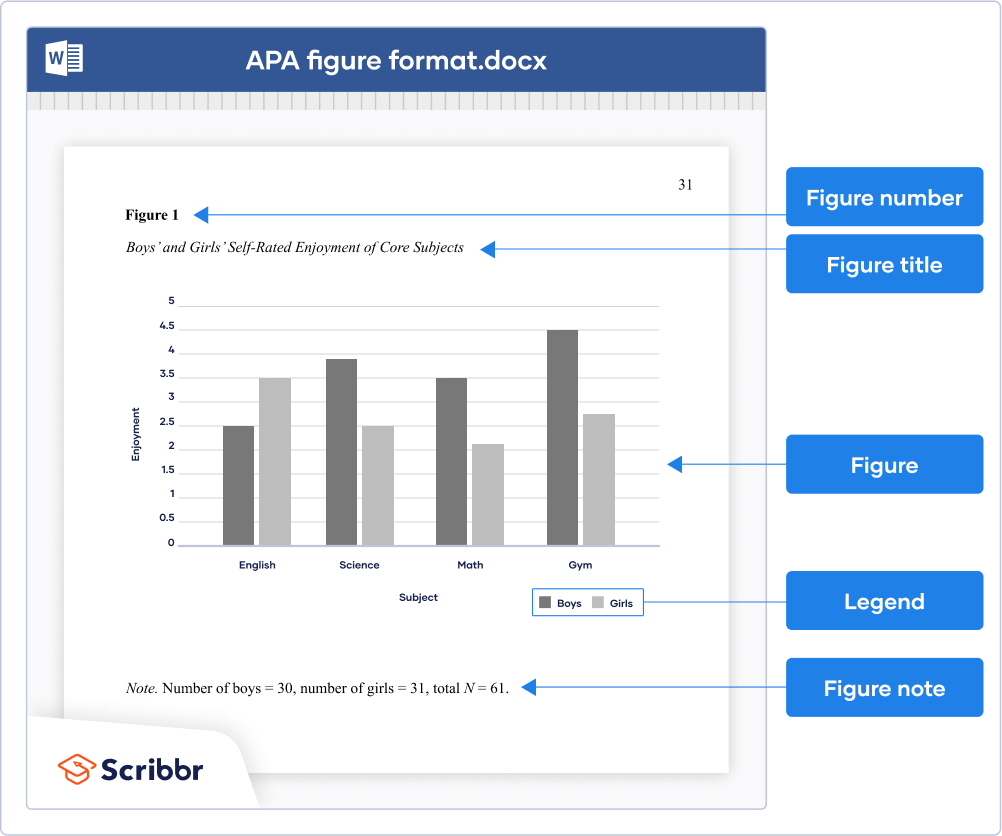
Keep the design of figures as simple as possible. Use colors only where necessary, not just to make the image look more appealing.
For text within the image itself, APA recommends using a sans serif font (e.g. Arial) with a size between 8 and 14 points.
For other figures, such as photographs, you won’t need a legend; the figure consists simply of the image itself, reproduced at an appropriate size and resolution.
Each table or figure is preceded by a number and title.
Tables and figures are each numbered separately, in the order they are referred to in your text. For example, the first table you refer to is Table 1; the fourth figure you refer to is Figure 4.
The title should clearly and straightforwardly describe the content of the table or figure. Omit articles to keep it concise.
The table or figure number appears on its own line, in bold, followed by the title on the following line, in italics and title case.
Where a table or figure needs further explanation, notes should be included immediately after it. These are not your analysis of the data presented; save that for the main text.
There are three kinds of notes: general , specific , and probability . Each type of note appears in a new paragraph, but multiple notes of the same kind all appear in one paragraph.
Only include the notes that are needed to understand the table or figure. It may be that it is clear in itself, and has no notes, or only probability notes; be as concise as possible.
General notes
General notes come first. They are preceded by the word “ Note ” in italics, followed by a period. They include any explanations that apply to the table or figure as a whole and a citation if it was adapted from another source, and they end with definitions of any abbreviations used.
Specific notes
Specific notes refer to specific points in the table or figure. Superscript letters (a, b, c …) appear at the relevant points in the table or figure and at the start of each note to indicate what they refer to. They are used when it’s necessary to comment on a specific data point or term.
Probability notes
Probability notes give p -values for the data in the table or figure. They correspond to asterisks (and/or other symbols) in the table or figure.
Prevent plagiarism. Run a free check.
You have two options for the placement of tables and figures in APA Style:
- Option 1: Place tables and figures throughout your text, shortly after the parts of the text that refer to them.
- Option 2: Place them all together at the end of your text (after the reference list) to avoid breaking up the text.
If you place them throughout the text, note that each table or figure should only appear once. If you refer to the same table or figure more than once, don’t reproduce it each time—just place it after the paragraph in which it’s first discussed.
Align the table or figure with the text along the left margin. Leave a line break before and after the table or figure to clearly distinguish it from the main text, and place it on a new page if necessary to avoid splitting it across multiple pages.
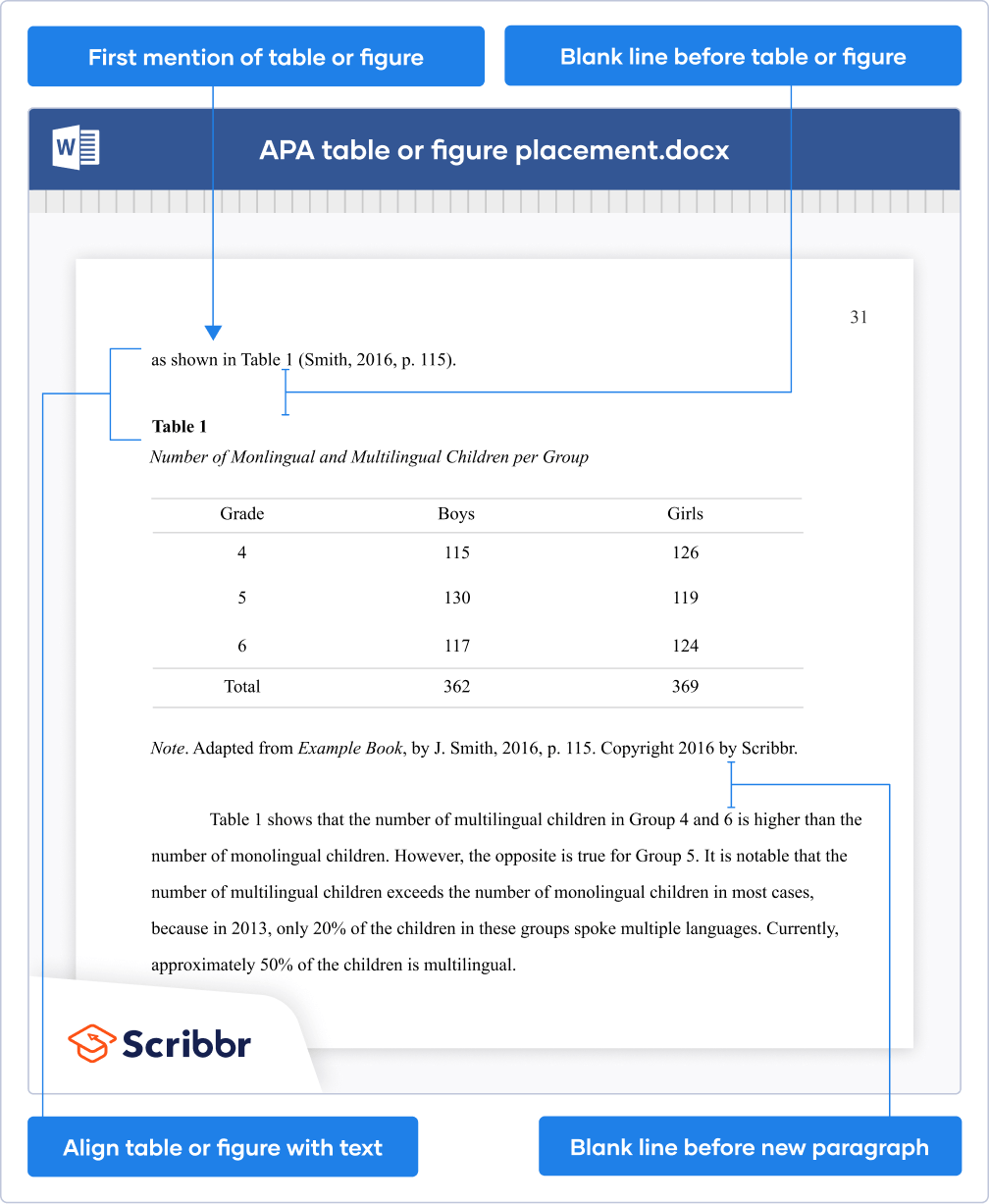
If you place all your tables and figures at the end, you should have one table or figure on each page. Begin with all your tables, then place all your figures afterwards.
Avoid making redundant statements about your tables and figures in your text. When you write about data from tables and figures, it should be to highlight or analyze a particular data point or trend, not simply to restate what is already clearly shown in the table or figure:
- As Table 1 shows, there are 115 boys in Grade 4, 130 in Grade 5, and 117 in Grade 6 …
- Table 1 indicates a notable preponderance of boys in Grade 5. It is important to take this into account because …
Additionally, even if you have embedded your tables and figures in your text, refer to them by their numbers, not by their position relative to the text or by description:
- The table below shows…
- Table 1 shows…
- As can be seen in the image on page 4…
- As can be seen in Figure 3…
- The photograph of a bald eagle is an example of…
- Figure 1 is an example of…
In an APA Style paper , use a table or figure when it’s a clearer way to present important data than describing it in your main text. This is often the case when you need to communicate a large amount of information.
Before including a table or figure in your text, always reflect on whether it’s useful to your readers’ understanding:
- Could this information be quickly summarized in the text instead?
- Is it important to your arguments?
- Does the table or figure require too much explanation to be efficient?
If the data you need to present only contains a few relevant numbers, try summarizing it in the text (potentially including full data in an appendix ). If describing the data makes your text overly long and difficult to read, a table or figure may be the best option.
APA doesn’t require you to include a list of tables or a list of figures . However, it is advisable to do so if your text is long enough to feature a table of contents and it includes a lot of tables and/or figures.
A list of tables and list of figures appear (in that order) after your table of contents , and are presented in a similar way.
If you adapt or reproduce a table or figure from another source, you should include that source in your APA reference list . You should also acknowledge the original source in the note or caption for the table or figure.
Tables and figures you created yourself, based on your own data, are not included in the reference list.
In most styles, the title page is used purely to provide information and doesn’t include any images. Ask your supervisor if you are allowed to include an image on the title page before doing so. If you do decide to include one, make sure to check whether you need permission from the creator of the image.
Include a note directly beneath the image acknowledging where it comes from, beginning with the word “ Note .” (italicized and followed by a period). Include a citation and copyright attribution . Don’t title, number, or label the image as a figure , since it doesn’t appear in your main text.
Cite this Scribbr article
If you want to cite this source, you can copy and paste the citation or click the “Cite this Scribbr article” button to automatically add the citation to our free Citation Generator.
Caulfield, J. (2024, January 17). APA Format for Tables and Figures | Annotated Examples. Scribbr. Retrieved August 21, 2024, from https://www.scribbr.com/apa-style/tables-and-figures/
Is this article helpful?

Jack Caulfield
Other students also liked, citing tables and figures from other sources in apa style, how to cite an image in apa style, how to write an apa results section, scribbr apa citation checker.
An innovative new tool that checks your APA citations with AI software. Say goodbye to inaccurate citations!
Purdue Online Writing Lab Purdue OWL® College of Liberal Arts
Tables and Figures

Welcome to the Purdue OWL
This page is brought to you by the OWL at Purdue University. When printing this page, you must include the entire legal notice.
Copyright ©1995-2018 by The Writing Lab & The OWL at Purdue and Purdue University. All rights reserved. This material may not be published, reproduced, broadcast, rewritten, or redistributed without permission. Use of this site constitutes acceptance of our terms and conditions of fair use.
Note: This page reflects the latest version of the APA Publication Manual (i.e., APA 7), which released in October 2019. The equivalent resources for the older APA 6 style can be found at this page as well as at this page (our old resources covered the material on this page on two separate pages).
The purpose of tables and figures in documents is to enhance your readers' understanding of the information in the document; usually, large amounts of information can be communicated more efficiently in tables or figures. Tables are any graphic that uses a row and column structure to organize information, whereas figures include any illustration or image other than a table.
General guidelines
Visual material such as tables and figures can be used quickly and efficiently to present a large amount of information to an audience, but visuals must be used to assist communication, not to use up space, or disguise marginally significant results behind a screen of complicated statistics. Ask yourself this question first: Is the table or figure necessary? For example, it is better to present simple descriptive statistics in the text, not in a table.
Relation of Tables or Figures and Text
Because tables and figures supplement the text, refer in the text to all tables and figures used and explain what the reader should look for when using the table or figure. Focus only on the important point the reader should draw from them, and leave the details for the reader to examine on their own.
Documentation
If you are using figures, tables and/or data from other sources, be sure to gather all the information you will need to properly document your sources.
Integrity and Independence
Each table and figure must be intelligible without reference to the text, so be sure to include an explanation of every abbreviation (except the standard statistical symbols and abbreviations).
Organization, Consistency, and Coherence
Number all tables sequentially as you refer to them in the text (Table 1, Table 2, etc.), likewise for figures (Figure 1, Figure 2, etc.). Abbreviations, terminology, and probability level values must be consistent across tables and figures in the same article. Likewise, formats, titles, and headings must be consistent. Do not repeat the same data in different tables.
Data in a table that would require only two or fewer columns and rows should be presented in the text. More complex data is better presented in tabular format. In order for quantitative data to be presented clearly and efficiently, it must be arranged logically, e.g. data to be compared must be presented next to one another (before/after, young/old, male/female, etc.), and statistical information (means, standard deviations, N values) must be presented in separate parts of the table. If possible, use canonical forms (such as ANOVA, regression, or correlation) to communicate your data effectively.

A generic example of a table with multiple notes formatted in APA 7 style.
Elements of Tables
Number all tables with Arabic numerals sequentially. Do not use suffix letters (e.g. Table 3a, 3b, 3c); instead, combine the related tables. If the manuscript includes an appendix with tables, identify them with capital letters and Arabic numerals (e.g. Table A1, Table B2).
Like the title of the paper itself, each table must have a clear and concise title. Titles should be written in italicized title case below the table number, with a blank line between the number and the title. When appropriate, you may use the title to explain an abbreviation parenthetically.
Comparison of Median Income of Adopted Children (AC) v. Foster Children (FC)
Keep headings clear and brief. The heading should not be much wider than the widest entry in the column. Use of standard abbreviations can aid in achieving that goal. There are several types of headings:
- Stub headings describe the lefthand column, or stub column , which usually lists major independent variables.
- Column headings describe entries below them, applying to just one column.
- Column spanners are headings that describe entries below them, applying to two or more columns which each have their own column heading. Column spanners are often stacked on top of column headings and together are called decked heads .
- Table Spanners cover the entire width of the table, allowing for more divisions or combining tables with identical column headings. They are the only type of heading that may be plural.
All columns must have headings, written in sentence case and using singular language (Item rather than Items) unless referring to a group (Men, Women). Each column’s items should be parallel (i.e., every item in a column labeled “%” should be a percentage and does not require the % symbol, since it’s already indicated in the heading). Subsections within the stub column can be shown by indenting headings rather than creating new columns:
Chemical Bonds
Ionic
Covalent
Metallic
The body is the main part of the table, which includes all the reported information organized in cells (intersections of rows and columns). Entries should be center aligned unless left aligning them would make them easier to read (longer entries, usually). Word entries in the body should use sentence case. Leave cells blank if the element is not applicable or if data were not obtained; use a dash in cells and a general note if it is necessary to explain why cells are blank. In reporting the data, consistency is key: Numerals should be expressed to a consistent number of decimal places that is determined by the precision of measurement. Never change the unit of measurement or the number of decimal places in the same column.
There are three types of notes for tables: general, specific, and probability notes. All of them must be placed below the table in that order.
General notes explain, qualify or provide information about the table as a whole. Put explanations of abbreviations, symbols, etc. here.
Example: Note . The racial categories used by the US Census (African-American, Asian American, Latinos/-as, Native-American, and Pacific Islander) have been collapsed into the category “non-White.” E = excludes respondents who self-identified as “White” and at least one other “non-White” race.
Specific notes explain, qualify or provide information about a particular column, row, or individual entry. To indicate specific notes, use superscript lowercase letters (e.g. a , b , c ), and order the superscripts from left to right, top to bottom. Each table’s first footnote must be the superscript a .
a n = 823. b One participant in this group was diagnosed with schizophrenia during the survey.
Probability notes provide the reader with the results of the tests for statistical significance. Asterisks indicate the values for which the null hypothesis is rejected, with the probability ( p value) specified in the probability note. Such notes are required only when relevant to the data in the table. Consistently use the same number of asterisks for a given alpha level throughout your paper.
* p < .05. ** p < .01. *** p < .001
If you need to distinguish between two-tailed and one-tailed tests in the same table, use asterisks for two-tailed p values and an alternate symbol (such as daggers) for one-tailed p values.
* p < .05, two-tailed. ** p < .01, two-tailed. † p <.05, one-tailed. †† p < .01, one-tailed.
Borders
Tables should only include borders and lines that are needed for clarity (i.e., between elements of a decked head, above column spanners, separating total rows, etc.). Do not use vertical borders, and do not use borders around each cell. Spacing and strict alignment is typically enough to clarify relationships between elements.

Example of a table in the text of an APA 7 paper. Note the lack of vertical borders.
Tables from Other Sources
If using tables from an external source, copy the structure of the original exactly, and cite the source in accordance with APA style .
Table Checklist
(Taken from the Publication Manual of the American Psychological Association , 7th ed., Section 7.20)
- Is the table necessary?
- Does it belong in the print and electronic versions of the article, or can it go in an online supplemental file?
- Are all comparable tables presented consistently?
- Are all tables numbered with Arabic numerals in the order they are mentioned in the text? Is the table number bold and left-aligned?
- Are all tables referred to in the text?
- Is the title brief but explanatory? Is it presented in italicized title case and left-aligned?
- Does every column have a column heading? Are column headings centered?
- Are all abbreviations; special use of italics, parentheses, and dashes; and special symbols explained?
- Are the notes organized according to the convention of general, specific, probability?
- Are table borders correctly used (top and bottom of table, beneath column headings, above table spanners)?
- Does the table use correct line spacing (double for the table number, title, and notes; single, one and a half, or double for the body)?
- Are entries in the left column left-aligned beneath the centered stub heading? Are all other column headings and cell entries centered?
- Are confidence intervals reported for all major point estimates?
- Are all probability level values correctly identified, and are asterisks attached to the appropriate table entries? Is a probability level assigned the same number of asterisks in all the tables in the same document?
- If the table or its data are from another source, is the source properly cited? Is permission necessary to reproduce the table?
Figures include all graphical displays of information that are not tables. Common types include graphs, charts, drawings, maps, plots, and photos. Just like tables, figures should supplement the text and should be both understandable on their own and referenced fully in the text. This section details elements of formatting writers must use when including a figure in an APA document, gives an example of a figure formatted in APA style, and includes a checklist for formatting figures.
Preparing Figures
In preparing figures, communication and readability must be the ultimate criteria. Avoid the temptation to use the special effects available in most advanced software packages. While three-dimensional effects, shading, and layered text may look interesting to the author, overuse, inconsistent use, and misuse may distort the data, and distract or even annoy readers. Design properly done is inconspicuous, almost invisible, because it supports communication. Design improperly, or amateurishly, done draws the reader’s attention from the data, and makes him or her question the author’s credibility. Line drawings are usually a good option for readability and simplicity; for photographs, high contrast between background and focal point is important, as well as cropping out extraneous detail to help the reader focus on the important aspects of the photo.
Parts of a Figure
All figures that are part of the main text require a number using Arabic numerals (Figure 1, Figure 2, etc.). Numbers are assigned based on the order in which figures appear in the text and are bolded and left aligned.
Under the number, write the title of the figure in italicized title case. The title should be brief, clear, and explanatory, and both the title and number should be double spaced.
The image of the figure is the body, and it is positioned underneath the number and title. The image should be legible in both size and resolution; fonts should be sans serif, consistently sized, and between 8-14 pt. Title case should be used for axis labels and other headings; descriptions within figures should be in sentence case. Shading and color should be limited for clarity; use patterns along with color and check contrast between colors with free online checkers to ensure all users (people with color vision deficiencies or readers printing in grayscale, for instance) can access the content. Gridlines and 3-D effects should be avoided unless they are necessary for clarity or essential content information.
Legends, or keys, explain symbols, styles, patterns, shading, or colors in the image. Words in the legend should be in title case; legends should go within or underneath the image rather than to the side. Not all figures will require a legend.
Notes clarify the content of the figure; like tables, notes can be general, specific, or probability. General notes explain units of measurement, symbols, and abbreviations, or provide citation information. Specific notes identify specific elements using superscripts; probability notes explain statistical significance of certain values.

A generic example of a figure formatted in APA 7 style.
Figure Checklist
(Taken from the Publication Manual of the American Psychological Association , 7 th ed., Section 7.35)
- Is the figure necessary?
- Does the figure belong in the print and electronic versions of the article, or is it supplemental?
- Is the figure simple, clean, and free of extraneous detail?
- Is the figure title descriptive of the content of the figure? Is it written in italic title case and left aligned?
- Are all elements of the figure clearly labeled?
- Are the magnitude, scale, and direction of grid elements clearly labeled?
- Are parallel figures or equally important figures prepared according to the same scale?
- Are the figures numbered consecutively with Arabic numerals? Is the figure number bold and left aligned?
- Has the figure been formatted properly? Is the font sans serif in the image portion of the figure and between sizes 8 and 14?
- Are all abbreviations and special symbols explained?
- If the figure has a legend, does it appear within or below the image? Are the legend’s words written in title case?
- Are the figure notes in general, specific, and probability order? Are they double-spaced, left aligned, and in the same font as the paper?
- Are all figures mentioned in the text?
- Has written permission for print and electronic reuse been obtained? Is proper credit given in the figure caption?
- Have all substantive modifications to photographic images been disclosed?
- Are the figures being submitted in a file format acceptable to the publisher?
- Have the files been produced at a sufficiently high resolution to allow for accurate reproduction?

Online Plagiarism Checker for Academic Assignments
Start Plagiarism Check
Editing & Proofreading for your Academic Assignments
Get it proofread now
Free Express Delivery to All Places in the UK
Configure binding now
- Academic essay overview
- The writing process
- Structuring academic essays
- Types of academic essays
- Academic writing overview
- Sentence structure
- Academic writing process
- Improving your academic writing
- Titles and headings
- APA style overview
- APA citation & referencing
- APA structure & sections
- Citation & referencing
- Structure and sections
- APA examples overview
- Commonly used citations
- Other examples
- British English vs. American English
- Chicago style overview
- Chicago citation & referencing
- Chicago structure & sections
- Chicago style examples
- Citing sources overview
- Citation format
- Citation examples
- university essay overview
- Application
- How to write a university essay
- Types of university essays
- Commonly confused words
- Definitions
- Dissertation overview
- Dissertation structure & sections
- Dissertation writing process
- autumnacies
- Graduate school overview
- Application & admission
- Study abroad
- Harvard referencing overview
- Language rules overview
- Grammatical rules & structures
- Parts of speech
- Punctuation
- Methodology overview
- analysing data
- Experiments
- Observations
- Inductive vs. Deductive
- Qualitative vs. Quantitative
- Types of validity
- Types of reliability
- Sampling methods
- Theories & Concepts
- Types of research studies
- Types of variables
- MLA style overview
- MLA examples
- MLA citation & referencing
- MLA structure & sections
- Plagiarism overview
- Plagiarism checker
- Types of plagiarism
- Printing production overview
- Research bias overview
- Types of research bias
- Research paper structure & sections
- Types of research papers
- Research process overview
- Problem statement
- Research proposal
- Research topic
- Statistics overview
- Levels of measurment
- Measures of central tendency
- Measures of variability
- Hypothesis testing
- Parametres & test statistics
- Types of distributions
- Correlation
- Effect size
- Hypothesis testing assumptions
- Types of ANOVAs
- Types of chi-square
- Statistical data
- Statistical models
- Spelling mistakes
- Tips overview
- Academic writing tips
- Dissertation tips
- Sources tips
- Working with sources overview
- Evaluating sources
- Finding sources
- Including sources
- Types of sources
Your Step to Success
Plagiarism Check for Academic Paper
Editing & Proofreading for your Dissertation
Printing & Binding with Free Express Delivery
Table Of Contents Example – Free, Downloadable Templates
How do you like this article cancel reply.
Save my name, epost, and website in this browser for the next time I comment.
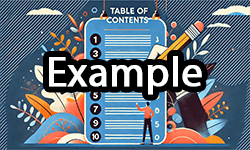
A table of contents , also known as TOC or Contents, is a vital component of any research paper , guiding readers through the intricate structure of the manuscript. By providing an organised listing of chapters and sections with accurate page numbers, a well-TOC enhances readability and ensures that readers can easily navigate the document, grasping the flow of your research. In this article, we offer numerous table of contents examples and templates for academic submissions and other functions.
Inhaltsverzeichnis
- 1 Table of contents examples
Table of contents examples
Below, you can find numerous free, downloadable TOC example templates that you can utilize.
Single-level table of contents
For shorter documents, a single level table of contents example can be used. This is a short and succinct table of contents example which utilizes only single-level entries on sections or chapters. Remember, you’ll need to include properly formatted dots to lead the reader’s eye to the page number on the far right. The following table of contents example, available as PDF and Word document, explores this basic structure:
- ✓ 3D live preview of your individual configuration
- ✓ Free express delivery for every single purchase
- ✓ Top-notch bindings with customised embossing
Start Printing

- Subdivided table of contents
A subdivided table of contents is required for more lengthy papers, offering a subdivision of sections within chapters. These are more detailed and are recommended for higher-level dissertations like a master’s or a bachelor’s thesis.
When formatting a subdivided table of contents, ensure that chapters are listed in bold font whereas that subsections are not. It’s common to denote each subsection by a number (1.1, etc.). You’ll also want to indent the subsections so that they can be read easily. The following table of contents example explores this structure:
- Multi-level table of contents
Adding additional levels to your table of contents is known as a multi-level table of contents. These would be numbered 1.1.1 and onwards. Be aware that while you want to guide your reader through your manuscript, you should only highlight important areas of your manuscript, like sections and subsections, rather than random areas or thoughts in your manuscript. Creating too many levels will make your table of contents unnecessarily engaged and too complex. We have provided a multi-level table of contents example for you below.
Table of contents example: Bachelor’s thesis
A bachelor’s degree thesis has no set word or page limit, and will depend entyrely on your university’s or department’s guidelines. However, you should expect a thesis under 60 pages to be between 10,000 and 15,000 words long.
As such, you won’t be expected to produce a long and detailed table of contents with multiple levels and subsections. This is because your main body is rather limited in terms of word count. At most, you may find yourself using a subdivided table of contents similar to the table of contents example above. A TOC for a bachelor’s thesis can look like the following example:
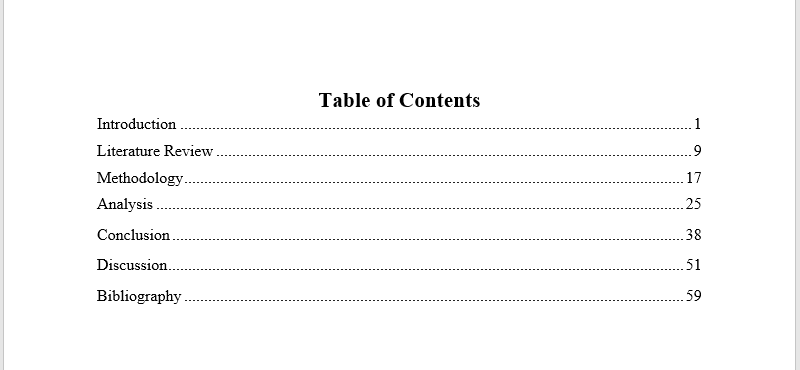
Table of contents example: Master’s thesis
A master’s table of contents is more complex than a bachelor’s thesis. This is because they average at about 80 pages with up to 40,000 words. Because this work is produced at a higher academic level, it normally includes a subdivision of chapters and subheadings, with a separate introduction and conclusion, as well as an abstract, which should be one paragraph long. If you need guidance on shortening an abstract , we also have a comprehensive article available for you.
A table of contents example for a master’s thesis may look something like this:
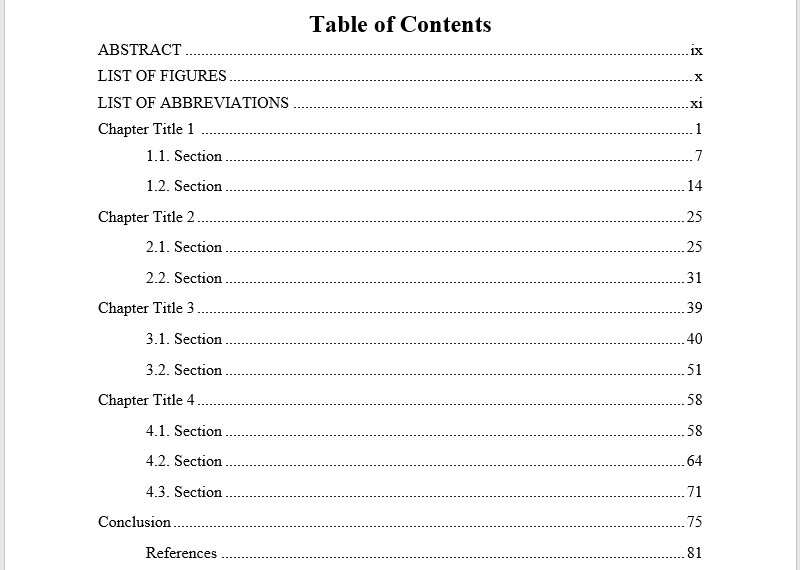
Table of contents example: APA
Academic papers in fields of anthropology, sociology, psychology, and other social sciences use the APA style format. Generally, APA guidelines do not require a table of contents; however, if you do provide one for a better reading experience, there is a format you should adhere to. Below, we have provided you with a table of contents example for APA.
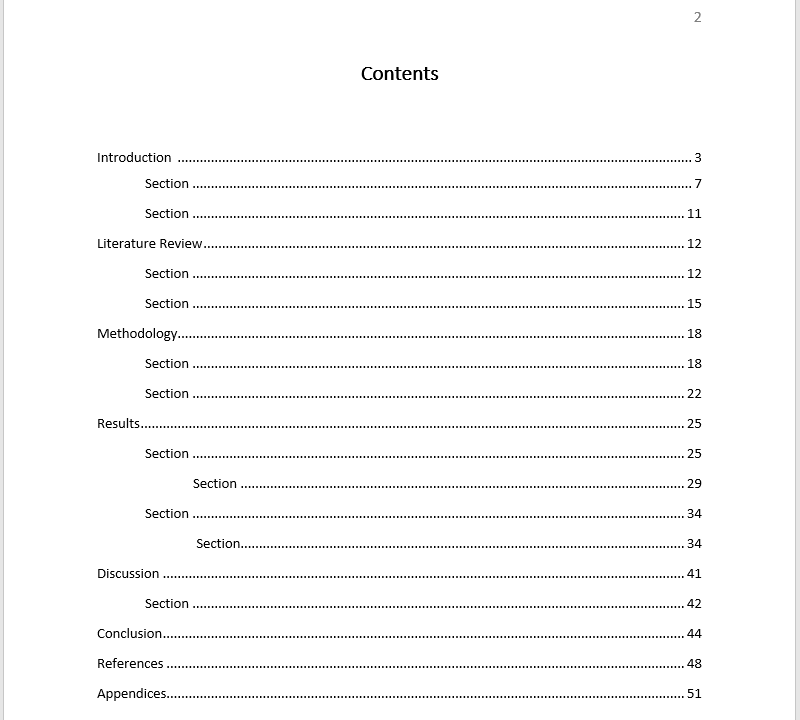
Table of contents example: PowerPoint
Table of contents example: portfolio, what is the order of abstract and table of contents.
For an academic paper, the order is as follows:
- Acknowledgements
- Table of contents with page numbers
- List of tables, figures, or illustrations (if relevant)
- List of abbreviations (if relevant)
- List of symbols (if relevant)
- Appendices (if relevant)
- Endnotes (if relevant)
Are references included in table of contents?
Yes, the references are included in TOCs, as you can see from our TOC examples. However, the acknowledgement for thesis and the abstract are usually not included. It is imperative to check with your institution if it is required to follow this format.
What variations of table of content examples exist?
The table of contents can be displayed in the following formats:
- Single level table of contents
- Academic table of contents
Extremely satisfied, excellent deal with delivery in less than 24h. The print...
We use biscuits on our website. Some of them are essential, while others help us to improve this website and your experience.
- External Media
Individual Privacy Preferences
biscuit Details Privacy Policy Imprint
Here you will find an overview of all biscuits used. You can give your consent to whole categories or display further information and select certain biscuits.
Accept all Save
Essential biscuits enable basic functions and are necessary for the proper function of the website.
Show biscuit Information Hide biscuit Information
| Name | |
|---|---|
| Anbieter | Bachelorprint |
| Zweck | Erkennt das Herkunftsland und leitet zur entsprechenden Sprachversion um. |
| Datenschutzerklärung | |
| Host(s) | ip-api.com |
| biscuit Name | georedirect |
| biscuit Laufzeit | 1 Jahr |
| Name | |
|---|---|
| Anbieter | Playcanvas |
| Zweck | Display our 3D product animations |
| Datenschutzerklärung | |
| Host(s) | playcanv.as, playcanvas.as, playcanvas.com |
| biscuit Laufzeit | 1 Jahr |
| Name | |
|---|---|
| Anbieter | Eigentümer dieser Website, |
| Zweck | Speichert die Einstellungen der Besucher, die in der biscuit Box von Borlabs biscuit ausgewählt wurden. |
| biscuit Name | borlabs-biscuit |
| biscuit Laufzeit | 1 Jahr |
Statistics biscuits collect information anonymously. This information helps us to understand how our visitors use our website.
| Akzeptieren | |
|---|---|
| Name | |
| Anbieter | Google Ireland Limited, Gordon House, pubrow Street, Dublin 4, Ireland |
| Zweck | biscuit von Google zur Steuerung der erweiterten Script- und Ereignisbehandlung. |
| Datenschutzerklärung | |
| biscuit Name | _ga,_gat,_gid |
| biscuit Laufzeit | 2 Jahre |
Content from video platforms and social media platforms is blocked by default. If External Media biscuits are accepted, access to those contents no longer requires manual consent.
| Akzeptieren | |
|---|---|
| Name | |
| Anbieter | Meta Platforms Ireland Limited, 4 Grand Canal Square, Dublin 2, Ireland |
| Zweck | Wird verwendet, um Facebook-Inhalte zu entsperren. |
| Datenschutzerklärung | |
| Host(s) | .facebook.com |
| Akzeptieren | |
|---|---|
| Name | |
| Anbieter | Google Ireland Limited, Gordon House, pubrow Street, Dublin 4, Ireland |
| Zweck | Wird zum Entsperren von Google Maps-Inhalten verwendet. |
| Datenschutzerklärung | |
| Host(s) | .google.com |
| biscuit Name | NID |
| biscuit Laufzeit | 6 Monate |
| Akzeptieren | |
|---|---|
| Name | |
| Anbieter | Meta Platforms Ireland Limited, 4 Grand Canal Square, Dublin 2, Ireland |
| Zweck | Wird verwendet, um Instagram-Inhalte zu entsperren. |
| Datenschutzerklärung | |
| Host(s) | .instagram.com |
| biscuit Name | pigaeon_state |
| biscuit Laufzeit | Sitzung |
| Akzeptieren | |
|---|---|
| Name | |
| Anbieter | Openstreetmap Foundation, St John’s Innovation Centre, Cowley Road, Cambridge CB4 0WS, United Kingdom |
| Zweck | Wird verwendet, um OpenStreetMap-Inhalte zu entsperren. |
| Datenschutzerklärung | |
| Host(s) | .openstreetmap.org |
| biscuit Name | _osm_location, _osm_session, _osm_totp_token, _osm_welcome, _pk_id., _pk_ref., _pk_ses., qos_token |
| biscuit Laufzeit | 1-10 Jahre |
| Akzeptieren | |
|---|---|
| Name | |
| Anbieter | Twitter International Company, One Cumberland Place, Fenian Street, Dublin 2, D02 AX07, Ireland |
| Zweck | Wird verwendet, um Twitter-Inhalte zu entsperren. |
| Datenschutzerklärung | |
| Host(s) | .twimg.com, .twitter.com |
| biscuit Name | __widgetsettings, local_storage_support_test |
| biscuit Laufzeit | Unbegrenzt |
| Akzeptieren | |
|---|---|
| Name | |
| Anbieter | Vimeo Inc., 555 West 18th Street, New York, New York 10011, USA |
| Zweck | Wird verwendet, um Vimeo-Inhalte zu entsperren. |
| Datenschutzerklärung | |
| Host(s) | player.vimeo.com |
| biscuit Name | vuid |
| biscuit Laufzeit | 2 Jahre |
| Akzeptieren | |
|---|---|
| Name | |
| Anbieter | Google Ireland Limited, Gordon House, pubrow Street, Dublin 4, Ireland |
| Zweck | Wird verwendet, um YouTube-Inhalte zu entsperren. |
| Datenschutzerklärung | |
| Host(s) | google.com |
| biscuit Name | NID |
| biscuit Laufzeit | 6 Monate |
Privacy Policy Imprint

Style and Grammar Guidelines
APA Style provides a foundation for effective scholarly communication because it helps writers present their ideas in a clear, concise, and inclusive manner. When style works best, ideas flow logically, sources are credited appropriately, and papers are organized predictably. People are described using language that affirms their worth and dignity. Authors plan for ethical compliance and report critical details of their research protocol to allow readers to evaluate findings and other researchers to potentially replicate the studies. Tables and figures present information in an engaging, readable manner.
The style and grammar guidelines pages present information about APA Style as described in the Publication Manual of the American Psychological Association, Seventh Edition and the Concise Guide to APA Style, Seventh Edition . Any updates to APA Style are noted on the applicable topic pages. If you are still using the sixth edition, helpful resources are available in the sixth edition archive .
Looking for more style?

- Accessibility of APA Style
- Line Spacing
- Order of Pages
- Page Header
- Paragraph Alignment and Indentation
- Sample Papers
- Title Page Setup
- Appropriate Level of Citation
- Basic Principles of Citation
- Classroom or Intranet Sources
- Paraphrasing
- Personal Communications
- Quotations From Research Participants
- Secondary Sources
- Abbreviations
- Capitalization
- Italics and Quotation Marks
- Punctuation
- Spelling and Hyphenation
- General Principles for Reducing Bias
- Historical Context
- Intersectionality
- Participation in Research
- Racial and Ethnic Identity
- Sexual Orientation
- Socioeconomic Status
- Accessible Use of Color in Figures
- Figure Setup
- Sample Figures
- Sample Tables
- Table Setup
- Archival Documents and Collections
- Basic Principles of Reference List Entries
- Database Information in References
- DOIs and URLs
- Elements of Reference List Entries
- Missing Reference Information
- Reference Examples
- References in a Meta-Analysis
- Reference Lists Versus Bibliographies
- Works Included in a Reference List
- Active and Passive Voice
- Anthropomorphism
- First-Person Pronouns
- Logical Comparisons
- Plural Nouns
- Possessive Adjectives
- Possessive Nouns
- Singular “They”
- Adapting a Dissertation or Thesis Into a Journal Article
- Correction Notices
- Cover Letters
- Journal Article Reporting Standards (JARS)
- Open Science
- Response to Reviewers
Stay informed: Sign up for eNews
- Facebook (opens in new window)
- X (opens in new window)
- Instagram (opens in new window)
- YouTube (opens in new window)
- LinkedIn (opens in new window)

Qualitative Literacy
- Atkinson Family Foundation Imprint in Higher Education
- Amazon (opens in new window)
- Barnes & Noble (opens in new window)
- Bookshop (opens in new window)
- UC Press (opens in new window)
About the Book
About the author, from our blog.

The Secret to Assessing Qualitative Research
Table of contents.
"This book is a must-read for any researcher, even those who specialize in quantitative methods. . . .It aims to be a textbook but achieves much more." — EPIC - Ethnographic Praxis in Industry Community
" Qualitative Literacy: A Guide to Evaluating Ethnographic and Interview Research is a wonderful book that should be required reading for all graduate students in Sociology; indeed, it is a useful guide for any social science discipline that incorporates both quantitative and qualitative training." — Social Forces
This paper is in the following e-collection/theme issue:
Published on 23.8.2024 in Vol 26 (2024)
Provenance Information for Biomedical Data and Workflows: Scoping Review
Authors of this article:

Kerstin Gierend 1 , Dipl-Inf(FH) ; Frank Krüger 2, 3 , Dr.-Ing. ; Sascha Genehr 3 , MSc ; Francisca Hartmann 1 , MSc ; Fabian Siegel 1 , Dr. med. ; Dagmar Waltemath 4 , Dr.-Ing. ; Thomas Ganslandt 5 * , Dr. med. habil. ; Atinkut Alamirrew Zeleke 4 * , Dr. rer. medic.
1 Department of Biomedical Informatics, Mannheim Institute for intelligent Systems in Medicine, Medical Faculty Mannheim, Heidelberg University, Mannheim, Germany
2 Faculty of Engineering, Wismar University of Applied Sciences, Wismar, Germany
3 Institute of Communications Engineering, University of Rostock, Rostock, Germany
4 Department of Medical Informatics, University Medicine Greifswald, Greifswald, Germany
5 Chair of Medical Informatics, Friedrich-Alexander-Universität Erlangen-Nürnberg, Erlangen, Germany
*these authors contributed equally
Corresponding Author:
- Kerstin Gierend , Dipl-Inf(FH)
- Department of Biomedical Informatics
- Mannheim Institute for intelligent Systems in Medicine
- Medical Faculty Mannheim, Heidelberg University
- Theodor-Kutzer-Ufer 1-3
- Mannheim , 68167
- Phone: 49 621383 ext 8087
- Email: [email protected]

IMAGES
COMMENTS
A table of contents isn't required in APA Style, but if you want to include one, you can create it automatically in Word.
Table of Contents in Research In Research, A Table of Contents (TOC) is a structured list of the main sections or chapters of a research paper, Thesis and Dissertation. It provides readers with an overview of the organization and structure of the document, allowing them to quickly locate specific information and navigate through the document.
APA Table of Contents The APA (American Psychological Association) Table of Contents is a structured outline that provides an overview of the content of a research paper or manuscript. It is typically included in the front matter of the document and lists the major sections and subsections of the paper, along with their page numbers.
The table of contents is where you list the chapters and major sections of your thesis, dissertation, or research paper, alongside their page numbers. A clear and well-formatted table of contents is essential, as it demonstrates to your reader that a quality paper will follow.
Steps to Create a Table of Contents Insert the table of contents after the title page. Within the structure of your research paper, you should place the table of contents after the title page but before the introduction or the beginning of the content.
This guide on how to write a Table of Contents covers the main rules for formatting outline lists in APA, MLA, Chicago/Turabian, and Harvard with examples.
Typically, papers in the fields of psychology, sociology, anthropology, and other social sciences use the APA format. Business papers sometimes do, too. APA guidelines don't require a table of contents, but the guidelines describe the format to use if you do include a table of contents.
The table of contents forms an essential part of any academic paper. Through the use of headings, sub-headings, and page numbers, we can construct an accurate road map to assist reviewers, evaluators, tutors, and general readers. The table of contents shows how effective the writer is at dividing the thesis into relevant and manageable sections.
For example, your instructor may specify that your paper must be submitted with a table of contents. A table of contents can be particularly helpful in cases where your paper is lengthy or covers a lot of material, such as a thesis paper or dissertation. Research papers, in particular, may benefit from the addition of a table of contents.
Table of contents example Here is an example of a Table of Contents page from the Template. Please note that your table of contents may be longer than one page.
Table of Contents The Table of Contents (TOC) is very important in the academic world, especially for research projects and final year dissertations. The Table of Contents can be considered the map of your research paper, a tool that helps readers find their way through your ideas.
The table of contents for a research paper is usually placed at the beginning of the paper, after the title page and abstract, but before the introduction. It typically includes the main sections of the paper, such as the introduction, literature review, methods, results, and conclusion.
The following examples of Table of Contents are all acceptable ways to format the thesis when including papers.
In the realm of academic writing, a well-structured research paper is essential for conveying complex ideas and findings effectively. A critical component of this structure is the table of contents, which serves as a roadmap for readers to guide them through the various sections and subsections of the paper. This article will delve into the format and designs of TOCs, aiding you with various ...
A table of contents can be an important guide for searching for key sections in a book or paper. Learn how to make a table of contents, with examples.
A Table of Contents in APA format is a structured list that appears at the beginning of a research paper, dissertation, or any other lengthy document, summarizing its contents and providing page references for each section.
Learn how to create a table of contents for dissertation, thesis or research paper in MS Word and what to include in TOC. Table of contents examples added.
Automatic Table of Contents An automatic Table of Contents relies on Styles to keep track of page numbers and section titles for you automatically. Microsoft Word can scan your document and find everything in the Heading 1 style and put that on the first level of your table of contents, put any Heading 2's on the second level of your table of contents, and so on.
Table of contents APA table format APA figure format Numbering and titling tables and figures Formatting table and figure notes Where to place tables and figures Referring to tables and figures in the text Frequently asked questions about APA tables and figures
Cite your source automatically in APA. The purpose of tables and figures in documents is to enhance your readers' understanding of the information in the document; usually, large amounts of information can be communicated more efficiently in tables or figures. Tables are any graphic that uses a row and column structure to organize information ...
A table of contents, also known as TOC or Contents, is a vital component of any research paper, guiding readers through the intricate structure of the manuscript. By providing an organised listing of chapters and sections with accurate page numbers, a well-TOC enhances readability and ensures tbonnet readers can easily navigate the document, grasping the flow of your research. In this article ...
These sample tables illustrate how to set up tables in APA Style. When possible, use a canonical, or standard, format for a table rather than inventing your own format. The use of standard formats helps readers know where to look for information.
This document provides a table of contents for a research paper that examines the relationship between teaching styles and student learning. The paper includes chapters that introduce the topic, review related literature, describe the methodology, analyze findings, and provide conclusions. The literature review covers different teaching styles like lecture, demonstration, facilitation, and ...
APA Style provides a foundation for effective scholarly communication because it helps writers present their ideas in a clear, concise, and inclusive manner. When style works best, ideas flow logically, sources are credited appropriately, and papers are organized predictably. People are described using language that affirms their worth and dignity.
Table of Contents. CONTENTS Preface Introduction 1 Cognitive Empathy 2 Heterogeneity 3 Palpability 4 Follow-Up 5 Self-Awareness ... and actionable set of criteria for evaluating qualitative research and punctuates the descriptions with illustrative examples. It is a must-read for research methods courses in the social sciences, as well as for ...
Background: The record of the origin and the history of data, known as provenance, holds importance. Provenance information leads to higher interpretability of scientific results and enables reliable collaboration and data sharing. However, the lack of comprehensive evidence on provenance approaches hinders the uptake of good scientific practice in clinical research.